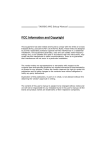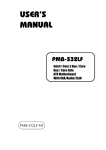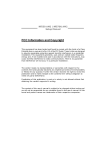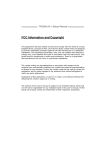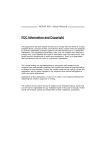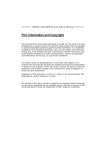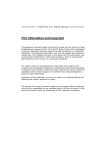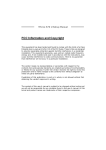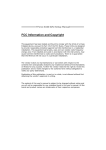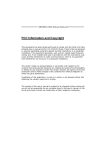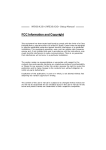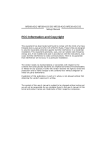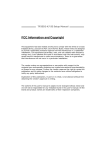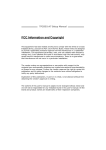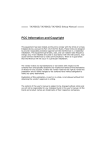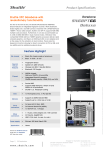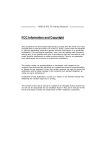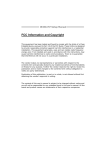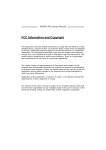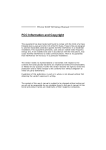Download Biostar TF7025-M2 Owner's Manual
Transcript
TF7050-M2/TF7025-M2 Setup Manual FCC Information and Copyright This equipment has been tes ted and found to comply with the limits of a Class B digital devic e, purs uant to Part 15 of the FCC Rules . T hese limits are designed to provide reasonable protec tion against harmful interference in a residential installation. T his equipment generates , uses and can radiate radio frequency energy and, if not ins talled and used in accordance with the instructions , may cause harmful interference to radio communications . There is no guarantee that interference will not occur in a particular ins tallation. The vendor makes no representations or warranties with respec t to the contents here and s pecially disclaims any implied warranties of merchantability or fitness for any purpose. Further the vendor reserves the right to revise this publication and to make c hanges to the c ontents here without obligation to notify any party beforehand. D uplication of this publication, in part or in whole, is not allowed without first obtaining the vendor’s approval in writing. The content of this user’s manual is subject to be c hanged without notice and we will not be res ponsible for any mis takes found in this user’s manual. All the brand and produc t names are trademarks of their respec tive companies . Table of Contents Chapter 1: Introduction ............................................. 3 1.1 1.2 1.3 1.4 1.5 1.6 1.7 Before You Start................................................................... 3 Package Checklist................................................................ 3 Motherboard Features.......................................................... 4 Rear Panel Connectors (for TF7050-M2) ................................ 6 Rear Panel Connectors (for TF7025-M2)................................. 7 Motherboard Layout (for TF7050-M2)................................... 8 Motherboard Layout (for TF7025-M2) ................................... 9 Chapter 2: Hardware Installation............................10 2.1 2.2 2.3 2.4 Installing Central Processing Unit (CPU) ...............................10 FAN Headers.......................................................................12 Installing System Memory.....................................................13 Connectors and Slots ............................................................15 Chapter 3: Headers & Jumpers Setup .....................17 3.1 3.2 How to Setup Jumpers..........................................................17 Detail Settings.....................................................................17 Chapter 4: RAID Functions.......................................25 4.1 4.2 4.3 Operation System................................................................25 Raid Arrays.........................................................................25 How RAID Works.................................................................25 Chapter 5: OverClock Quick Guide ..........................29 5.1 5.2 5.3 T-Power Introduction...........................................................29 T-Power BIOS Feature .........................................................30 T-Power Windows Feature...................................................36 Chapter 6: Useful Help .............................................43 6.1 6.2 6.3 6.4 Driver Installation Note .......................................................43 Award BIOS Beep Code........................................................44 Extra Information................................................................44 Troubleshooting...................................................................46 Appendencies: SPEC In Other Language ................48 German................................................................................................48 France..................................................................................................50 Italian..................................................................................................52 Spanish ................................................................................................54 Portuguese...........................................................................................56 Polish...................................................................................................58 Russian ................................................................................................60 Arabic..................................................................................................62 Japanese ..............................................................................................64 TF7050-M2/TF7025-M2 CHAPTER 1: INTRODUCTION 1.1 BEFORE YOU ST ART Thank you for choosing our product. Be fore you start installing the mothe rboard, please make sure you follow the instructions be low: Prepare a dry and stable work ing environment with sufficie nt lighting. Always disconne ct the compute r from powe r outle t be fore ope ration. Before you take the mothe rboard out from anti-static bag, ground yourse lf prope rly by touching any safe ly grounde d appliance, or use grounded wrist strap to remove the static charge. Avoid touching the compone nts on mothe rboard or the rear side of the board unless ne cessary. Hold the board on the edge , do not try to be nd or flex the board. 1.2 Do not leave any unfastene d small parts inside the case afte r installation. Loose parts will cause short circuits which may damage the equipment. Keep the compute r from dange rous a rea, such as hea t source , humid air and wate r. PACKAGE CHECKLIST HDD Cable X 1 Se rial ATA Cable X 1 Rear I/O Panel for ATX Case X 1 Use r’s Manual X 1 Fully Se tup Drive r C D X 1 FDD Cable X 1 (optional) USB 2.0 Cable X1 (optional) S/PDIF out Cable X 1 (optional) Se rial ATA Powe r Cable X 1 (optional) 3 Motherboard Manual 1.3 MOT HERBOARD FEAT URES TF7050-M2 CPU FSB Chipset TF7025-M2 Socket AM2 Socket AM2 AMD Athlon 64 / Athlon 64 FX / Athlon 64 x2 / AMD Athlon 64 / Athlon 64 FX / Athlon 64 x2 / Sempron processors Sempron processors AMD 64 Architecture enables 32 and 64 bit AMD 64 Architecture enables 32 and 64 bit computing computing Supports Hyper Transport and Cool=n=Quiet Supports Hyper Transport and Cool=n=Quiet Supports up to 1 GHz Bandwidth Supports up to 1 GHz Bandwidth Support HyperTransport Support HyperTransport GeForce 7050PV/NF 630a GeForce 7025/NF 630a ITE 8716F ITE 8716F Provides the most commonly used legacy Super Provides the most commonly used legacy Super Super I/O Main Memory Graphics IDE SATA II LAN 4 I/O functionality. I/O functionality. Low Pin Count Interface Low Pin Count Interface Environment Control initiatives, Environment Control initiatives, H/W Monitor H/W Monitor Fan Speed Controller Fan Speed Controller ITE's "Smart Guardian" function ITE's "Smart Guardian" function DDR2 DIMM Slots x 4 DDR2 DIMM Slots x 4 Max Memory Capacity 4GB Max Memory Capacity 4GB Each DIMM supports 256/512MB & 1GB DDR2 Each DIMM supports 256/512MB & 1GB DDR2 Dual Channel Mode DDR2 memory module Dual Channel Mode DDR2 memory module Supports DDR2 400/ 533 / 667 / 800 Supports DDR2 400/ 533 / 667 / 800 Registered DIMM and ECC DIMM is not Registered DIMM and ECC DIMM is not supported supported Integrated in GeForce 7050PV/NF630a Chipset Integrated in GeForce 7025/NF630a Chipset Max Shared Video Memory is 256MB Max Shared Video Memory is 256MB Integrated IDE Controller Integrated IDE Controller Ultra DMA 33 / 66 / 100 / 133 Bus Master Mode Ultra DMA 33 / 66 / 100 / 133 Bus Master Mode supports PIO Mode 0~4, supports PIO Mode 0~4, Integrated Serial ATA Controller Integrated Serial ATA Controller Data transfer rates up to 3 Gb/s. Data transfer rates up to 3 Gb/s. SATA Version 2.0 specification compliant. SATA Version 2.0 specification compliant. Realtek RTL 8111B / 8101E (optional) Realtek RTL 8111B / 8101E (optional) 10 / 100 Mb/s / 1Gb/s auto negotiation (Gigabit 10 / 100 Mb/s / 1Gb/s auto negotiation (Gigabit bandwidth is for RTL 8111B only) bandwidth is for RTL 8111B only) Half / Full duplex capability Half / Full duplex capability TF7050-M2/TF7025-M2 TF7050-M2 TF7025-M2 ALC888 (Ver 5.x) / ALC861VD (Ver 6.x) 7.1 channels audio out (Ver 5.x) / Sound 7.1 channels audio out (Ver 5.x) / 5.1 channels audio out (Ver 6.x) 5.1 channels audio out (Ver 6.x) High Definition Audio 2 channels audio out for HDMI Audio PCI slot Slots ALC888 (Ver 5.x) / ALC861VD (Ver 6.x) x2 High Definition Audio PCI slot x2 PCI Express x16 slot x1 PCI Express x16 slot x1 PCI Express x 1 slot x1 PCI Express x 1 slot x1 Floppy connector x1 Floppy connector x1 Printer Port connector x1 Printer Port connector x1 IDE Connector x1 IDE Connector x1 SATA Connector x4 SATA Connector x4 Front Panel Connector x1 Front Panel Connector x1 Front Audio Connector x1 Front Audio Connector x1 x1 CD-in Connector x1 CD-in Connector On Board S/PDIF out connector x1 S/PDIF out connector x1 Connector S/PDIF in connector (Optional) x1 S/PDIF in connector (Optional) x1 CPU Fan header x1 CPU Fan header x1 Back Panel I/O System Fan header x3 System Fan header x3 CMOS clear header x1 CMOS clear header x1 USB connector x3 USB connector x3 Serial port Connector x1 Serial port Connector x1 Power Connector (24pin) x1 Power Connector (24pin) x1 Power Connector (4pin) x1 Power Connector (4pin) x1 PS/2 Keyboard x1 PS/2 Mouse x1 S-Video port x1 HDMI port x1 VGA port x1 LAN port x1 USB Port x4 Audio Jack (for Ver 5.x) x6 Audio Jack (for Ver 6.x) x3 Board Size 235 mm(W) x 244 mm(L) Special Features PS/2 Keyboard x1 PS/2 Mouse x1 VGA port x1 DVI-D port x1 LAN port x1 USB Port x4 Audio Jack (for Ver 5.x) x6 Audio Jack (for Ver 6.x) x3 235 mm(W) x 244 mm(L) RAID 0 / 1 / 5 / 0+1 support RAID 0 / 1 / 5 / 0+1 support Windows 2000 / XP / VISTA Windows 2000 / XP / VISTA OS Support Biostar Reserves the right to add or remove support for any OS With or without notice. Biostar Reserves the right to add or remove support for any OS With or without notice. 5 Motherboard Manual 1.4 X Z REAR PANEL CONNECT ORS ( FOR TF7050-M2) PS/2 Mouse Port Y PS/2 Keyboard Port S-Video TV-Out Port Transmit anal og vi deo signals to TV or any other dis play panels equipped with S-Video input. [ HDMI Port The High-Definition Multimedia Interfac e (HDMI) is an all-digital audio/video interfac e capable of transmitting unc ompress ed s treams to an AV recei ver or any compatibl e digital audi o and/or video monitor, suc h as a digital television. The HDMI audio function is not s upported by Windows 2000 / XP. \ D-Sub VGA Port Transmit anal og vi deo signals to computer monitor or any other dis play panels equipped with D-Sub VGA input. ] USB 2.0 Port x 4 _ Audio Jack x 6 (for Ver 5.x) / Audio Jack x 3 (for Ver 6.x) Port Blue Green Pink Orange Black Grey ^ RJ-45 LAN Port 2-Channel Line-In Line-Out Mic In 4-Channel Line-In Front Speaker Out Mic In Rear Speaker Out Rear Speaker Out 6-Channel/8-Channel Line-In Front Speaker Out Mic In Center/Subwoofer Rear Speaker Out Side Speaker Out NOTE: The HDMI audio is c urrentl y onl y s upported by Wi ndows VISTA. NOTE: The GeForce 7050PV/NF630a chips et uses the same c hannel to control S-Video and D-Sub for trans mitting anal og vi deo signals, so these ports c annot work simultaneousl y. 6 TF7050-M2/TF7025-M2 1.5 X Z REAR PANEL CONNECT ORS ( FOR TF7025-M2) PS/2 Mouse Port Y PS/2 Keyboard Port DVI-D VGA Port The Digital Visual Interface (DVI) is a video i nterface trans mitting digital video signals to digital display devices s uch as flat panel LCDs or digital projectors. The DVI-D connector allows digital signals trans mission onl y. [ D-Sub VGA Port Transmit anal og vi deo signals to computer monitor or any other dis play panels equipped with D-Sub VGA input. \ ^ USB 2.0 Port x 4 ] RJ-45 LAN Port Audio Jack x 6 (for Ver 5.x) / Audio Jack x 3 (for Ver 6.x) Port Blue Green Pink Orange Black Grey 2-Channel Line-In Line-Out Mic In 4-Channel Line-In Front Speaker Out Mic In Rear Speaker Out Rear Speaker Out 6-Channel/8-Channel Line-In Front Speaker Out Mic In Center/Subwoofer Rear Speaker Out Side Speaker Out 7 Motherboard Manual 1.6 MOT HERBOARD LAYOUT ( FOR TF7050-M2) JKBMS1 JTVOUT1 JHDMI JAT XPWR2 DIMMB2 DIMMA2 JATXPWR1 JUSBLAN1 JCFAN1 IDE1 JUSB1 JAUDIO2 (for Ver 5.x) JAUDIO1 (for Ver 6.x) JAUDIOF1 GeForce 7050PV/ NF630a JNFAN1 JUSBV2 PEX1_1 LED_D1 LED_D2 PCI1 Super I/O JCOM1 BIOS SATA1 BAT1 SATA2 SATA3 JSPDIF_I N1 JSPDI F_O UT1 SATA4 JCMOS1 PCI2 Codec JSFAN2 JUSB2 JUSB3 JUSB4 PEX16_1 LAN JPRNT1 F DD1 JCDIN1 JSFAN1 JPANEL1 PWRSW1 RSTSW1 st Not e: ■ represe nts the 1 pin. 8 DIMMB1 A M2 DIMMA1 Socket VGA JUSBV1 TF7050-M2/TF7025-M2 1.7 MOT HERBOARD LAYOUT ( FOR TF7025-M2) JKBMS1 JAT XPWR2 VGA DIMMB2 DIMMA2 DIMMB1 A M2 DIMMA1 Socket DVI-D JUSBV1 JATXPWR1 JUSBLAN1 JCFAN1 IDE1 JUSB1 JAUDIO2 (for Ver 5.x) JAUDIO1 (for Ver 6.x) JAUDIOF1 GeForce 7025 / NF630a JNFAN1 JUSBV2 PEX1_1 JUSB2 JUSB3 JUSB4 LED_D1 LED_D2 PEX16_1 LAN PCI1 Super I/O JCOM1 BIOS SATA1 BAT1 SATA2 SATA3 JSPDI F_IN1 JSPDIF_O UT1 SATA4 JCMOS1 PCI2 Codec JSFAN2 JPR NT1 F DD1 JCDIN1 JSFAN1 JPANEL1 PWRSW1 RSTSW1 st Not e: ■ represe nts the 1 pin. 9 Motherboard Manual CHAPTER 2: HARDWARE INSTALLATION 2.1 INST ALLING CENT RAL PROCESSING UNIT (CPU) Step 1: Remove the socket protection cap. Step 2: Pull the lever toward direction A from the socket and then raise the lever up to a 90-degree angle. Step 3: Look for the white triangle on socket, and the gold triangle on CPU should point towards this white triangle. The CPU will fit only in the correct orientation. 10 TF7050-M2/TF7025-M2 Step 4: Hold the CPU down firmly, and then close the lever toward direct B to complete the installation. Step 5: Put the CPU Fan on the CPU and buckle it. Connect the CPU FAN power cable to the JCFAN1. This completes the installation. 11 Motherboard Manual 2.2 FAN HEADERS These fan headers support cooling-fans built in the computer. The fan cable and connector may be different according to the fan manufacturer. Connect the fan cable to the connector while matching the black wire to pin#1. JCFAN1: CPU Fan Heade r 4 1 Pin Assignment Ground +12V FAN RPM rate sense Smart Fan Control (By Fan) 1 2 3 4 JNFAN1: North Bridge Fan Heade r JSFAN1/JSFAN2: Syste m Fan Heade r JNFAN1 1 3 JSFAN2 3 1 Pin 1 2 3 Assignment Ground +12V FAN RPM rate sense JSFAN1 3 1 Note: The JCFAN1 supports 4-pin head c onnector. The J SFAN1/JSFAN2 and JNFAN1 support 3-pi n head connectors. When connec ting with wires onto connec tors, pleas e note that the red wire is the positive and should be connec ted to pin#2, and the blac k wire is Ground and s hould be c onnected to GND. 12 TF7050-M2/TF7025-M2 2.3 INST ALLING SYST EM MEMORY DIM MA1 DIM MB1 DIM MA2 DIM MB2 A. Memory Modules 1. Unlock a DIMM slot by pressing the retaining clips outward. Align a DIMM on the slot such that the notch on the DIMM matches the break on the Slot. 2. Insert the DIMM vertically and firmly into the slot until the retaining chip snap back in place and the DIMM is properly seated. 13 Motherboard Manual B. Memory Capacity DIMM Socket Location DIMMA1 256MB/512MB/1024MB DIMMB1 256MB/512MB/1024MB DIMMA2 256MB/512MB/1024MB DIMMB2 256MB/512MB/1024MB DDR2 Module Total Memory Size Max is 4GB. C. Dual Channel Memory installation To trigger the Dual Channel f unction of the motherboard, the memory module must meet the following requirements: Install memory module of the same density in pairs, shown in the f ollowing table. Dual Channel Status Enabled DIMMA1 O DIMMB1 O DIMMA2 X DIMMB2 X Enabled X X O O Enabled O O O O (O means memory installed, X means memory not installed.) The DRAM bus width of the memory module must be the same (x8 or x16) 14 TF7050-M2/TF7025-M2 2.4 CONNECT ORS AND SLOT S FDD1: Floppy Disk Conne ctor The motherboard prov ides a standard floppy disk connector that supports 360K, 720K, 1.2M, 1.44M and 2.88M floppy disk ty pes. This connector supports the prov ided f loppy drive ribbon cables. 2 34 1 33 IDE1: Hard Disk Conne ctor The motherboard has a 32-bit Enhanced PCI IDE Controller that prov ides PIO Mode 0~4, Bus Master, and Ultra DMA 33/66/100/133 f unctionality. The IDE connector can connect a master and a slave drive, so y ou can connect up to two hard disk driv es. 40 39 2 1 15 Motherboard Manual PEX16_1: PCI-Express x16 Slot - PCI-Express 1.0a compliant. - Maximum theoretical realized bandwidth of 4GB/s simultaneously per direction, f or an aggregate of 8GB/s totally. PEX1_1: PCI-Expre ss x1 slots - PCI-Express 1.0a compliant. - Data transf er bandwidth up to 250MB/s per direction; 500MB/s in total. PCI-Express supports a raw bit-rate of 2.5GB/s on the data pins. 2X bandwidth ov er the traditional PCI architecture. PEX1_1 PEX16_1 PCI1~PCI2: Pe riphe ral Component Interconne ct Slots This motherboard is equipped with 2 standard PCI slots. PCI stands f or Peripheral Component Interconnect, and it is a bus standard for expansion cards. This PCI slot is designated as 32 bits. PCI1 PCI2 16 TF7050-M2/TF7025-M2 CHAPTER 3: HEADERS & JUMPERS SETUP 3.1 HOW T O SET UP JUMPERS The illustration shows how to set up jumpers. When the jumper cap is placed on pins, the jumper is “close”, if not, that means the jumper is “open”. Pin opened 3.2 Pin closed Pin1-2 closed DET AIL SETT INGS JPANEL1: Front Panel Heade r This 16-pin connector includes Power-on, Reset, HDD LED, Power LED, Sleep button and speaker connection. It allows user to connect the PC case’s f ront panel switch functions. SLP PWR_LED On/ Off + + - 9 1 + SPK Pin 1 2 3 4 5 6 7 8 Assignment +5V N/A N/A Speaker HDD LED (+) HDD LED (-) Ground Reset control Functio n Speaker Connector Hard drive LED Reset button Pin 9 10 11 12 13 14 15 16 16 8 RST HLED Assignment Sleep control Ground N/A Power LED (+) Power LED (+) Power LED (-) Power button Ground Functio n Sleep button N/A Power LED Power-on button 17 Motherboard Manual JATXPWR1: ATX Powe r Source Conne ctor This connector allows user to connect 24-pin power connector on the ATX power supply. Pin 13 14 15 16 17 18 19 20 21 22 23 24 Assignment +3.3V -12V Ground PS_ON Ground Ground Ground NC +5V +5V +5V Ground Pin 1 2 3 4 5 6 7 8 9 10 11 12 12 24 1 13 Assignment +3.3V +3.3V Ground +5V Ground +5V Ground PW_OK Standby Voltage+5V +12V +12V +3.3V JATXPWR2: ATX Powe r Source Conne ctor By connecting this connector, it will provide +12V to CPU power circuit. 18 2 1 3 4 Pin 1 2 3 4 Assignment +12V +12V Ground Ground TF7050-M2/TF7025-M2 JUSB2/JUSB3/JUSB4: He ade rs for USB 2.0 Ports at Front Panel This header allows user to connect additional USB cable on the PC f ront panel, and also can be connected with internal USB devices, like USB card reader. Pin Assignment 1 2 +5V (fused) +5V (fused) 3 4 USBUSB- 5 6 USB+ USB+ 7 8 Ground Ground 9 10 Key NC JUSB2 JUSB3 JUS B4 2 1 10 9 JUSBV1/JUSBV2: Powe r Source Heade rs for USB Ports Pin 1-2 Close: JUSBV1: +5V for USB ports at JUSB1/JUSBLAN1. JUSBV2: +5V for USB ports at f ront panel (JUSB2/JUSB3/JUSB4). Pin 2-3 Close: JUSBV1: USB ports at JUSB1/JUSBLAN1 are powered by +5V standby v oltage. JUSBV2: USB ports at front panel (JUSB2/JUSB3/JUSB4) are powered by +5V standby voltage. JUSBV1 1 3 1 3 Pin 1-2 close 1 1 3 3 3 1 3 1 JU SBV2 Pin 2-3 close Note: In order to s upport this function “Power-On s ystem vi a USB devic e,” “JUSBV1/ JUSBV2” jumper cap should be plac ed on Pin 2-3 indi viduall y. 19 Motherboard Manual SATA1~SATA4: Se rial ATA Connectors The motherboard has a PCI to SATA Controller with 4 channels SATA interf ace. Pin 1 2 3 4 5 6 7 SATA 1 SATA3 SATA2 SATA4 7 4 Assignment Ground T X+ T XGround RXRX+ Ground 1 JAUDIO F1: Front Panel Audio Heade r This header allows user to connect the front audio output cable with the PC f ront panel. It will disable the output on back panel audio connectors. 1 2 9 10 Pin 1 2 3 4 5 6 7 8 9 10 Assignment Mic Left in Ground Mic Right in GPIO Right line in Jack Sense Front Sense Key Left line in Jack Sense JCDIN1: CD-RO M Audio-in Connector This connector allows user to connect the audio source f rom the v ariaty dev ices, like CD-ROM, DVD-ROM, PCI sound card, PCI TV turner card etc.. Pin 1 2 3 4 4 20 1 Assignment Left Channel Input Ground Ground Right Channel Input TF7050-M2/TF7025-M2 JCMO S1: Cle ar CMOS Heade r By placing the jumper on pin2-3, it allows user to restore the BIOS saf e setting and the CMOS data, please carefully f ollow the procedures to avoid damaging the motherboard. 3 1 Pin 1-2 Close: Normal Operation (default). 3 3 1 1 Pin 2-3 Close: Clear CMOS data. ※ Clear CMOS Proce dures: 1. 2. 3. 4. 5. 6. Remov e AC power line. Set the jumper to “Pin 2-3 close”. Wait f or f ive seconds. Set the jumper to “Pin 1-2 close”. Power on the AC. Reset y our desired password or clear the CMOS data. 21 Motherboard Manual JSPDIF_O UT1: Digital Audio-out Conne ctor This connector allows user to connect the PCI bracket SPDIF output header. Pin 1 2 3 3 Assignment +5V SPDIF_OUT Ground 1 JCO M1: Se rial port Conne ctor The motherboard has a Serial Port Connector for connecting RS-232 Port. 22 2 10 1 9 Pin 1 2 3 4 5 6 7 8 9 10 Assignment Carrier detect Received data T ransmitted data Data terminal ready Signal ground Data set ready Request to send Clear to send Ring indicator Key TF7050-M2/TF7025-M2 On-Board Buttons There are 2 on-board buttons. PWRSW1 RS TSW1 PWRSW1: This is an on-board Power Switch button. RSTSW1: This is an on-board Reset button. On-Board LED Indicators LED_D1 LED_D2 There are 2 LED indicators on the motherboard to show system status. LED_D1 and LED_D2: These 2 LED indicate system power on diagnostics. Please ref er to the table below for different messages: LED_D1 ON ON OFF OFF LED_D2 ON OFF ON OFF Message Normal Memory Error VGA Error Abnormal: CPU / Chipset error. 23 Motherboard Manual JPRNT1: Printe r Port Connector This header allows you to connector printer on the PC. 2 25 1 Pin 1 2 3 4 5 6 7 8 9 10 11 12 13 Assignment -Strobe -ALF Data 0 -Error Data 1 -Init Data 2 -Scltin Data 3 Ground Data 4 Ground Data 5 Pin 14 15 16 17 18 19 20 21 22 23 24 25 26 Assignment Ground Data 6 Ground Data 7 Ground -ACK Ground Busy Ground PE Ground SCLT Key JSPDIF_IN1: Digital Audio-out Connector (Optional) This connector allows user to connect the PCI bracket SPDIF input header. Pin 1 2 3 3 24 1 Assignment +5V SPDIF_IN Ground TF7050-M2/TF7025-M2 CHAPTER 4: RAID FUNCTIONS 4.1 O PERAT ION SYST EM z Supports Windows XP Home/Prof essional Edition, and Windows 2000 Prof essional. 4.2 RAID ARRAYS RAID supports the following types of RAID arrays: RAID 0: RAID 0 defines a disk striping scheme that improves disk read and write times for many applications. RAID 1: RAID 1 defines techniques for mirroring data. RAID 0+1: RAID 0+1 combines the techniques used in RAID 0 and RAID 1. RAID 5: RAID 5 provides fault tolerance and better utilization of disk capacity. 4.3 HOW RAID WORKS RAID 0: The controller “ stripes” data across multiple drives in a RAID 0 array system. It breaks up a large file into smaller blocks and performs disk reads and writes across multiple drives in parallel. The size of each block is determined by the stripe size parameter, which you set during the creation of the RAID set based on the system environment. This technique reduces overall disk access time and offers high bandwidth. Features and Benefits Drives: Minimum 1, and maximum is up to 6 or 8. Depending on the platf orm. Uses: Intended for non-critical data requiring high data throughput, or any env ironment that does not require f ault tolerance. Benefits: prov ides increased data throughput, especially f or large files. No capacity loss penalty f or parity. Drawbacks: Does not deliver any fault tolerance. If any drive in the array f ails, all data is lost. Fault Tolerance: No. Blo ck 1 Bl ock 3 Bl ock 5 Block 2 Bl ock 4 Bl ock 6 25 Motherboard Manual RAID 1: Every read and write is actually carried out in parallel across 2 disk drives in a RAID 1 array system. The mirrored (backup) copy of the data can reside on the same disk or on a second redundant drive in the array. RAID 1 provides a hot-standby copy of data if the active volume or drive is corrupted or becomes unavailable because of a hardware failure. RAID techniques can be applied for high-availability solutions, or as a form of automatic backup that eliminates tedious manual backups to more expensive and less reliable media. Features and Benefits Drives: Minimum 2, and maximum is 2. Uses: RAID 1 is ideal f or small databases or any other application that requires f ault tolerance and minimal capacity. Benefits: Prov ides 100% data redundancy. Should one driv e f ail, the controller switches to the other drive. Drawbacks: Requires 2 driv es for the storage space of one driv e. Perf ormance is impaired during driv e rebuilds. Fault Tolerance: Yes. Block 1 Block 2 Block 3 26 Block 1 Block 2 Block 3 TF7050-M2/TF7025-M2 RAID 0+1: RAID 0 drives can be mirrored using RAID 1 techniques. Resulting in a RAID 0+1 solution for improved performance plus resiliency. Features and Benefits Drives: Minimum 4, and maximum is 6 or 8, depending on the platform. Benefits: Optimizes for both fault tolerance and perf ormance, allowing for automatic redundancy. May be simultaneously used with other RAID lev els in an array, and allows for spare disks. Drawbacks: Requires twice the available disk space f or data redundancy, the same as RAID level 1. Fault Tolerance: Yes. GeF or ce 7050PV or GeF or ce 7025 Block 1 Bl ock 3 Bl ock 5 Bl ock 2 Bl ock 4 Bl ock 6 Bl ock 1 Block 3 Block 5 Block 2 Block 4 Block 6 27 Motherboard Manual RAID 5: RAID 5 stripes both data and parity information across three or more drives. It writes data and parity blocks across all the drives in the array. Fault tolerance is maintained by ensuring that the parity information for any given block of data is placed on a different drive from those used to store the data itself. Features and Benefits Drives: Minimum 3. Uses: RAID 5 is recommended for transaction processing and general purpose service. Benefits: An ideal combination of good perf ormance, good f ault tolerance, and high capacity and storage efficiency. Drawbacks: Individual block data transfer rate same as a single disk. Write perf ormance can be CPU intensiv e. Fault Tolerance: Yes. Dis k 1 DATA 1 DATA 3 PARITY DATA 7 DATA 9 PARITY Dis k 2 Ge Force 705 0PV or Ge Force 70 25 DATA 2 PARITY DATA 5 DATA 8 PARITY DATA 11 Dis k 3 PARITY DATA 4 DATA 6 PARITY DATA 10 DATA 12 ※ 28 For more detailed setup information, please refer to the Driver CD, or go to http://www.nvidia.com/page/pg_20011106217193.html to download NVIDIA nForce Tutorial Flash. TF7050-M2/TF7025-M2 CHAPTER 5: OVERCLOCK QUICK GUIDE 5.1 T-POWER INT RODUCT ION Biostar T-Power is a whole new utility that is designed for overclock users. Based on many precise tests, Biostar Engineering Team (BET) has developed this ultimate overclock engine to raise system performance. No matter whether under BIOS or Windows interface, T-Power is able to present the best system state according to users’ overclock setting. T-Powe r BIOS Fe ature s: Ov erclocking Nav igator Engine (O.N.E.) CMOS Reloading Program (C.R.P.) Memory Integration Test (M.I.T., under Ov erclock Nav igator Engine) Integrated Flash Program (I.F.P.) Self Recov ery System (S.R.S) T-Powe r Windows Fe ature : Hardware Monitor Ov erclock Engine Liv e Update !! WARNING !! For better system perform ance, the BIOS firmware is being continuously updated. The BIOS information described below in this manual is for your reference only and the actual BIOS inform ation and settings on board may be different from this manual. For further inform ation of setting up the BIOS, please refer to the BIOS Manual in the Setup CD. 29 Motherboard Manual 5.2 T-POWER BIOS FEAT URE A. Overclocking Navigator Engine (O.N.E.): ONE provides two powerful overclocking engines: MOS and AOS for both Elite and Casual overclockers. Manual O ve rclock System (M.O .S.) MOS is designed f or experienced overclock users. It allows users to customize personal overclock settings. 30 TF7050-M2/TF7025-M2 CPU Frequency: CPU Frequency is directly in proportion to system perf ormance. To maintain the system stability, CPU v oltage needs to be increased also when raising CPU frequency. K8<->NB HT Speed This f unction allows y ou to choose K8<->NB HT Speed. K8<->NB HT Width This f unction allows y ou to choose K8<->NB HT Width. DRAM Configuration Enter this function for more advanced DRAM settings. CPU Spread Spectrum This item allows you to select the CPU Spread Spectrum function. PCIE Spread Spectrum This item allows you to select the PCIE Spread Spectrum function. SATA Spread Spectrum This item allows you to select the SATA Spread Spectrum f unction. iGPU Spread Spectrum This item allows you to select the iGPU Spread Spectrum f unction. PCIE Clock: It helps to increase VGA card performance. CPU Voltage: This f unction will increase CPU stability when overclocking. Howev er, the CPU temperature will increase when CPU voltage is increased. DDR Voltage: This f unction will increase memory stability when ov erclocking. NB Voltage: This f unction will increase chipset stability when ov erclocking. 31 Motherboard Manual Automatic O ve rclock System (A.O.S.) For beginners in overclock f ield, BET had developed an easy, fast, and powerf ul feature to increase the system performance, named A.O.S. Based on many tests and experiments, A.O.S. prov ides 3 ideal overclock conf igurations that are able to raise the system perf ormance in a single step. V6 Tech Engine: This setting will raise about 10%~15% of whole system perf ormance. V8 Tech Engine: This setting will raise about 15%~25% of whole system perf ormance. 32 TF7050-M2/TF7025-M2 V12 Tech Engine: This setting will raise about 25%~30% of whole system perf ormance. Notices: 1. 2. Not all types of AMD CPU perform above overclock setting ideally; the difference will be based on the selected CPU model. From BET experiments, the Atholon64 FX CPU is not suitable for this A.O.S. feature. B. CMOS Reloading Program (C.R.P.): It allows users to sav e different CMOS settings into BIOS-ROM. Users are able to reload any sav ed CMOS setting for customizing system conf igurations. Moreov er, users are able to save an ideal overclock setting during overclock operation. There are 50 sets of record addresses in total, and users are able to name the CMOS data according to personal preference. 33 Motherboard Manual C. Memory Integration Test (M.I.T.): This f unction is under “Ov erclocking Nav igator Engine” item. MIT allows users to test memory compatibilities, and no extra devices or software are needed. Step 1: The def ault setting under this item is “Disabled”; the condition parameter should be changed to “Enable” to proceed this test. ↓ Step 2: Sav e and Exit f rom CMOS setup and reboot the system to activ ate this test. Run this test for 5 minutes (minimum) to ensure the memory stability. Step 3: When the process is done, change the setting back from “Enable” to “Disable” to complete the test. 34 TF7050-M2/TF7025-M2 D. Self Recovery System (S.R.S.): This f unction can’t be seen under T-Power BIOS setup; and is alway s on whenev er the system starts up. Howev er, it can prev ent system hang-up due to inappropriate overclock actions. When the system hangs up, S.R.S. will automatically log in the default BIOS setting, and all overclock settings will be re-configured. E. Integrated Flash Program (I.F.P.): IFP is a saf e and quick way to upgrade BIOS. Step 1: Go to Biostar website (http://www.biostar.com.tw) to download the latest BIOS f ile. Then, sav e the f ile into a floppy disk. Step 2: Insert the f loppy disk and reboot the system to get into CMOS screen. Step 3: Select the item “Integrated Flash Program” to get the following f rame and choose the BIOS file downloaded in step 1. Step 4: Press “Enter” key to start BIOS file loading, and BIOS updating will process automatically. Step 5: When the BIOS update is completed, press Y ES to the message “Flash done, Reset system”, and the system will reboot automatically to f inish the process. Advis e: You can update the system BIOS by simply pr essing “Enter ” key for three times. 35 Motherboard Manual 5.3 T-POWER WINDOWS FEAT URE A.Hardware Monitor: T-Power Hardware monitor allows users to monitor system voltage, temperature and fan speed accordingly. Additionally, a rescue action will be taken by the program automatically while the system faces an abnormal condition. The program will trigger an alarm or shut down the system when unpredictable errors occur. All the monitoring items are illustrated by a waveform diagram. Hardware Monitor Toolbar i. Start-up Setting Click on this item to run Hardware Monitor Program when the Windows starts-up. ii. Dialogue-Box Setting Click on this item to pop-up warning dialogue-box when PC system is abnormal. iii. Exit Click on this item to exit Hardware Monitor Program. iv. Hide Click on this item to hide this program in system tray. When hiding the program, there will be a check icon in the system tray. 36 TF7050-M2/TF7025-M2 CPU Te mpe rature This column configures the CPU temperature. There is a wav ef orm to represent the status of CPU temperature. By adjusting , users can easily configure the upper limit of CPU temperature f or system operating. In this diagram, the white line represents the upper limit which user-set f or CPU temperature and the green line shows present CPU temperature. If the CPU temperature is higher than the upper limit, the status line color will change f rom green to red, and a warning sound will alert y ou. Also, the system tray icon would change to . FAN Spee d By adjusting , users can easily configure the lower limit of the f an speed. In this diagram, the green line shows present CPU Fan speed, and the y ellow line shows System Fan speed (if any ). If any one of the f ans speeds is lower than the set value, the status line will change into a red warning line, and the program will trigger an alarm system automatically. Also, the system tray icon would change to . 37 Motherboard Manual CPU/Batte ry Voltage i. VCore This item displays the CPU voltage, represented by a light blue line. Users can set the upper and lower limit by adjusting to monitor the CPU operating voltage. If CPU v oltage is higher or lower than the set value, the status line will change into a red warning line, and a warning sound will alert y ou. Also, the system tray icon will change to . ii. VBAT This item displays the CMOS battery v oltage, represented by a light green line. Users can set the upper and lower limit by adjusting to monitor the status of battery v oltage. If battery voltage is higher or lower than the set v alue, the status line will change to a red warning line, and a warning sound will alert y ou. Also, the sy stem tray icon will change to . Refe rence data This column represents the status of power supply voltage and cannot be adjusted, it is only f or present status reference. 38 TF7050-M2/TF7025-M2 B. Overclocking Configurations This diagram is designed for T-series Ov erclocking utility. Friendly interf ace and solid ov erclock features are the major concept of this utility. Graphic 1 will appear when activ ating this utility. Graphic 1 A. B. C. D. E. F. Graphic 2 G. H. Clicking on “Biostar” will lead y ou to the Biostar Homepage. This column shows the CPU speed inf ormation. Click on this button and the utility will pop-up 4 sub-screens (Please refers to Graphic 3). Click on this button to minimize this program to taskbar. This column shows present CPU speed and ov erclocking percentage. Clicking on this button will make the program start up as soon as the Windows starts up. Click on this button to exit this overclock utility. Click on this button to reset all the ov erclock features to default setting. By adjusting the overclocking f eatures in 4 sub-screens, users can tune the system perf ormance to an optimal level. Graphic 3 39 Motherboard Manual CPU Ov erclocking Settings: can configure three items By adjusting for CPU overclocking. A. CPU Frequency Range: 200MHz~450MHz. Inter val: 1MHz. B. CPU Ratio Range: 4~ 25. Inter val: 1. C. CPU Voltage Range: 0.8V~ 2.0V. Inter val: 0.0125V. Memory Overclocking Settings: By adjusting can configure two items for Memory overclocking. A. Memory Clock Frequency Choices: 100, 133, 200, 266, 333, 400, 533, 667, 800. B. Memory Voltage Range: 1.8V~ 2.8V. Inter val: 0.1V. AGP/PCI-Express Overclocking Setting: By adjusting can configure VGA card overclocking. And this function helps to increase VGA card performance. Range: 100MHz~150MHz. Inter val: 1MHz. 40 TF7050-M2/TF7025-M2 PCI Overclocking Setting: This diagram shows present PCI working status and helps to monitor PCI peripherals working status. This item cannot be adjusted. 41 Motherboard Manual C. Live Update When Live Update program is activated, a screen will pop up to illustrate BIOS related information. i. Link to Internet: Click on this button wi ll link to Biostar website and BIOS file will be downloaded. ii. Update BIOS: Click on this button to r un BIOS flashi ng pr ocess, and it’s easy and safe. iii. Backup BIOS: Click on this button, and BIOS file wi ll be sav ed into the user -select ed folder. iv. Clear CMOS: Click on this item wi ll c lear the CMOS Data. When car r ying this job, the pr evious CMOS data would be clear ed and r etur ned to default setting. 42 TF7050-M2/TF7025-M2 CHAPTER 6: USEFUL HELP 6.1 DRIVER INST ALLAT ION NOT E After you installed your operating system, please insert the Fully Setup Driver CD into your optical drive and install the driver for better system performance. You will see the following window after you insert the CD The setup guide will auto detect your motherboard and operating system. Note: If this window didn’t show up after you ins ert the Driver CD, please use file brows er to locate and execute the file SETUP.EXE under your optical drive. A. Driver Installation To install the driver, please click on the Driver icon. The setup guide will list the compatible driver for your motherboard and operating system. Click on each device driver to launch the installation program. B. Software Installation To install the software, please click on the Software icon. The setup guide will list the software available for your system, click on each software title to launch the installation program. C. Manual Aside from the paperback manual, we also provide manual in the Driver CD. Click on the Manual icon to browse for available manual. Note: You will need Acrobat R eader to open the manual file. Pleas e download the latest version of Acrobat Reader software from http://www.adobe.com/products/acrobat/readstep 2.html 43 Motherboard Manual 6.2 AWARD BIOS BEEP CODE Beep Sound One long beep followed by two short beeps High-low siren sound Meaning Video card not found or v ideo card memory bad CPU overheated System will shut down automatically One Short beep when system boot-up No error found during POST Long beeps every other second 6.3 No DRAM detected or install EXT RA INFORMAT ION A. BIOS Update After you fail to update BIOS or BIOS is invaded by virus, the Boot-Block function will help to restore BIOS. If the following message is shown after boot-up the system, it means the BIOS contents are corrupted. In this Case, please follow the procedure below to restore the BIOS: 1. Make a bootable floppy disk. 2. Download the Flash Utility “AWDFLASH.exe” from the Biostar website: www.biostar.com.tw 3. Confirm motherboard model and download the respectively BIOS from Biostar website. 4. Copy “AWDFLASH.exe” and respectively BIOS into floppy disk. 5. Insert the bootable disk into floppy drive and press Enter. 6. System will boot-up to DOS prompt. 7. Type “Awdflash xxxx.bf/sn/py/r” in DOS prompt. (xxxx means BIOS name.) 8. System will update BIOS automatically and restart. 9. The BIOS has been recovered and will work properly. 44 TF7050-M2/TF7025-M2 B. CPU Overheated If the system shutdown automatically after power on system for seconds, that means the CPU protection function has been activated. When the CPU is over heated, the motherboard will shutdown automatically to avoid a damage of the CPU, and the system may not power on again. In this case, please double check: 1. The CPU cooler surface is placed evenly with the CPU surface. 2. CPU fan is rotated normally. 3. CPU fan speed is fulfilling with the CPU speed. After confirmed, please follow steps below to relief the CPU protection function. 1. Remove the power cord from power supply for seconds. 2. Wait for seconds. 3. Plug in the power cord and boot up the system. Or you can: 1. Clear the CMOS data. (See “Close CMOS Header: JCMOS1” section) 2. Wait for seconds. 3. Power on the system again. 45 Motherboard Manual 6.4 TROUBLESHOOT ING Probable Solution 1. Make sure power cable is No power to the system at all securely plugged in. Power light don’t illuminate, f an inside power supply does not turn 2. Replace cable. on. 3. Contact technical support. 2. Indicator light on key board does not turn on. System inoperativ e. Keyboard lights Using even pressure on both ends of are on, power indicator lights are lit, the DIMM, press down firmly until the and hard driv e is spinning. module snaps into place. 1. System does not boot from hard disk 1. driv e, can be booted f rom optical driv e. Check cable running from disk to disk controller board. Make sure both ends are securely plugged in; check the driv e type in the standard CMOS setup. 2. Backing up the hard drive is extremely important. All hard disks are capable of breaking down at any time. 1. Back up data and applications System only boots f rom optical driv e. f iles. Hard disk can be read and applications can be used but booting from hard disk 2. Ref ormat the hard driv e. is impossible. Re-install applications and data using backup disks. Screen message says “Invalid Rev iew system’s equipment. Make sure Conf iguration” or “CMOS Failure.” correct inf ormation is in setup. Cannot boot system after installing 1. Set master/slave jumpers second hard driv e. correctly. 2. Run SETUP program and select correct driv e types. Call the drive manuf acturers f or compatibility with other drives. 46 TF7050-M2/TF7025-M2 This page is intentionally left blank. 47 Motherboard Manual APPENDENCIES: SPEC IN OTHER LANGUAGE GERMAN TF7050-M2 Sockel AM2 TF7025-M2 Sockel AM2 AMD Athlon 64 / Athlon 64 FX / Athlon 64 x2 / AMD Athlon 64 / Athlon 64 FX / Athlon 64 x2/ CPU FSB Chipsatz Super E/A Sempron Prozessoren Sempron Prozessoren Die AMD 64-Architektur unterstützt eine 32-Bit- Die AMD 64-Architektur unterstützt eine 32-Bitund 64-Bit-Datenverarbeitung und 64-Bit-Datenverarbeitung Unterstützt Hyper Transport und Cool’n’Quiet Unterstützt Hyper Transport und Cool’n’Quiet Unterstützt HyperTransport mit einer Bandbreite Unterstützt HyperTransport mit einer Bandbreite von bis zu 1 GHz von bis zu 1 GHz GeForce 7050PV/NF 630a GeForce 7025/NF 630a ITE 8716F ITE 8716F Bietet die häufig verwendeten alten Super Bietet die häufig verwendeten alten Super E/A-Funktionen. E/A-Funktionen. Low Pin Count-Schnittstelle Low Pin Count-Schnittstelle Umgebungskontrolle, Umgebungskontrolle, Hardware-Überwachung Hardware-Überwachung Lüfterdrehzahl-Controller Lüfterdrehzahl-Controller "Smart Guardian"-Funktion von ITE "Smart Guardian"-Funktion von ITE DDR2 DIMM-Steckplätze x 4 DDR2 DIMM-Steckplätze x 4 Max. 4GB Arbeitsspeicher Max. 4GB Arbeitsspeicher Jeder DIMM unterstützt 256/512MB & 1GB Jeder DIMM unterstützt 256/512MB & 1GB Arbeitsspeich DDR2. DDR2. er Dual-Kanal DDR2 Speichermodul Dual-Kanal DDR2 Speichermodul Unterstützt DDR2 400 / 533 / 667 / 800 Unterstützt DDR2 400 / 533 / 667 / 800 registrierte DIMMs. ECC DIMMs werden nicht registrierte DIMMs. ECC DIMMs werden nicht unterstützt. unterstützt. Integrierter GeForce 7050PV/NF630a-Chipsatz Integrierter GeForce 7025/NF630a-Chipsatz Grafik IDE SATA II Max. 256MB gemeinsam benutzter Max. 256MB gemeinsam benutzter Videospeicher Videospeicher Integrierter IDE-Controller Integrierter IDE-Controller Ultra DMA 33 / 66 / 100 / 133 Bus Ultra DMA 33 / 66 / 100 / 133 Bus Master-Modus Master-Modus Unterstützt PIO-Modus 0~4, Unterstützt PIO-Modus 0~4, Integrierter Serial ATA-Controller Integrierter Serial ATA-Controller Datentransferrate bis zu 3Gb/s Datentransferrate bis zu 3Gb/s Konform mit der SATA-Spezifikation Version 2.0. Konform mit der SATA-Spezifikation Version 2.0. LAN 48 Realtek RTL 8111B / 8101E (optional) Realtek RTL 8111B / 8101E (optional) 10 / 100 / 1000 Mb/s Auto-Negotiation 10 / 100 / 1000 Mb/s Auto-Negotiation (Gigabit-Bandbreite nur beim RTL 8111B ) (Gigabit-Bandbreite nur beim RTL 8111B ) Halb-/ Vollduplex-Funktion Halb-/ Vollduplex-Funktion TF7050-M2/TF7025-M2 TF7050-M2 TF7025-M2 ALC888 (Ver 5.x) / ALC861VD (Ver 6.x) 7.1-Kanal-Audioausgabe (Ver 5.x) / 7.1-Kanal-Audioausgabe (Ver 5.x) Audio-Codec 5.1-Kanal-Audioausgabe (Ver 6.x) 5.1-Kanal-Audioausgabe (Ver 6.x) Unterstützt High-Definition Audio 2-Kanal-Audioausgabe (HDMI Audio) Steckplätze /A Platinengröße . Sonderfunkti onen OS-Unterstüt zung Unterstützt High-Definition Audio PCI-Steckplatz x2 PCI-Steckplatz PCI Express x16 Steckplatz x1 PCI Express x16 Steckplatz x1 PCI Express x 1-Steckplatz x1 PCI Express x 1-Steckplatz x1 Diskettenlaufwerkanschluss x1 Diskettenlaufwerkanschluss x1 Druckeranschluss Anschluss x1 Druckeranschluss Anschluss x1 IDE-Anschluss x1 IDE-Anschluss x1 SATA-Anschluss x4 SATA-Anschluss x4 Fronttafelanschluss x1 Fronttafelanschluss x1 Front-Audioanschluss x1 Front-Audioanschluss x1 CD-IN-Anschluss x1 S/PDIF- Ausgangsanschluss x1 CD-IN-Anschluss x1 Onboard-Ans S/PDIF- Ausgangsanschluss x1 chluss S/PDIF Eingangsanschluss (optional) x1 Rückseiten-E ALC888 (Ver 5.x) / ALC861VD (Ver 6.x) x2 S/PDIF Eingangsanschluss (optional) x1 CPU-Lüfter-Sockel x1 CPU-Lüfter-Sockel System-Lüfter-Sockel x3 System-Lüfter-Sockel x3 "CMOS löschen"-Sockel x1 "CMOS löschen"-Sockel x1 USB-Anschluss x3 USB-Anschluss x3 Serieller Anschluss x1 Serieller Anschluss x1 Stromanschluss (24-polig) x1 Stromanschluss (24-polig) x1 Stromanschluss (4-polig) x1 Stromanschluss (4-polig) x1 PS/2-Tastatur x1 PS/2-Maus x1 S-Video-Anschluss x1 HDMI-Anschluss x1 VGA-Anschluss x1 LAN-Anschluss x1 USB-Anschluss x4 Audioanschluss (Ver 5.x) x6 Audioanschluss (Ver 6.x) x3 x1 PS/2-Tastatur x1 PS/2-Maus x1 VGA-Anschluss x1 DVI-D-Anschluss x1 LAN-Anschluss x1 USB-Anschluss x4 Audioanschluss (Ver 5.x) x6 Audioanschluss (Ver 6.x) x3 235 mm (B) X 244 mm (L) 235 mm (B) X 244 mm (L) Unterstützt RAID 0 / 1 / 5 / 0+1 Unterstützt RAID 0 / 1 / 5 / 0+1 Windows 2000 / XP / VISTA Windows 2000 / XP / VISTA Biostar behält sich das Recht vor, ohne Biostar behält sich das Recht vor, ohne Ankündigung die Unterstützung für ein Ankündigung die Unterstützung für ein Betriebssystem hinzuzufügen oder zu Betriebssystem hinzuzufügen oder zu entfernen. entfernen. 49 Motherboard Manual FRANCE TF7050-M2 UC TF7025-M2 Socket AM2 Socket AM2 Processeurs AMD Athlon 64 / Athlon 64 FX / Processeurs AMD Athlon 64 / Athlon 64 FX / Athlon 64 x2 / Sempron Athlon 64 x2 / Sempron L'architecture AMD 64 permet le calcul 32 et 64 L'architecture AMD 64 permet le calcul 32 et 64 bits bits Prend en charge Hyper Transport et Cool’n’Quiet Prend en charge Hyper Transport et Cool’n’Quiet Bus frontal Chipset Super E/S Mémoire principale Graphiques IDE SATA II Prend en charge Hyper Transport jusqu'à une Prend en charge Hyper Transport jusqu'à une bande passante de1 GHz bande passante de1 GHz GeForce 7050PV/NF 630a GeForce 7025/NF 630a ITE 8716F ITE 8716F Fournit la fonctionnalité de Super E/S Fournit la fonctionnalité de Super E/S patrimoniales la plus utilisée. patrimoniales la plus utilisée. Interface à faible compte de broches Interface à faible compte de broches Initiatives de contrôle environnementales, Initiatives de contrôle environnementales, Moniteur de matériel Moniteur de matériel Contrôleur de vitesse de ventilateur Contrôleur de vitesse de ventilateur Fonction "Gardien intelligent" de l'ITE Fonction "Gardien intelligent" de l'ITE Fentes DDR2 DIMM x 4 Fentes DDR2 DIMM x 4 Capacité mémoire maximale de 4 Go Capacité mémoire maximale de 4 Go Chaque DIMM prend en charge des DDR2 de Chaque DIMM prend en charge des DDR2 de 256/512 Mo et 1Go 256/512 Mo et 1Go Module de mémoire DDR2 à mode à double voie Module de mémoire DDR2 à mode à double voie Prend en charge la DDR2 400 / 533 / 667 / 800 Prend en charge la DDR2 400 / 533 / 667 / 800 Les DIMM à registres et DIMM avec code Les DIMM à registres et DIMM avec code correcteurs d'erreurs ne sont pas prises en correcteurs d'erreurs ne sont pas prises en charge charge Integré dans la chipset GeForce 7050PV/NF630a Integré dans la chipset GeForce 7025/NF630a Mémoire vidéo partagée maximale de 256 Mo Mémoire vidéo partagée maximale de 256 Mo Contrôleur IDE intégré Contrôleur IDE intégré Mode principale de Bus Ultra DMA 33 / 66 / 100 / Mode principale de Bus Ultra DMA 33 / 66 / 100 / 133 133 Prend en charge le mode PIO 0~4, Prend en charge le mode PIO 0~4, Contrôleur Serial ATA intégré : Contrôleur Serial ATA intégré : Taux de transfert jusqu'à 3 Go/s. Taux de transfert jusqu'à 3 Go/s. Conforme à la spécification SATA Version 2.0 Conforme à la spécification SATA Version 2.0 Realtek RTL 8111B / 8101E (optional) Realtek RTL 8111B / 8101E (optional) 10 / 100 / 1000 Mb/s négociation automatique 10 / 100 / 1000 Mb/s négociation automatique LAN 50 (La bande passante Gigabit est pour le RTL (La bande passante Gigabit est pour le RTL 8111B uniquement) 8111B uniquement) Half / Full duplex capability Half / Full duplex capability TF7050-M2/TF7025-M2 TF7050-M2 TF7025-M2 ALC888 (Ver 5.x) / ALC861VD (Ver 6.x) Sortie audio à 7.1 voies (Ver 5.x) / Sortie audio à 7.1 voies (Ver 5.x) / Codec audio Sortie audio à 5.1 voies (Ver 6.x) Prise en charge de l'audio haute definition Sortie audio à 2 voies (HDMI audio) Fentes Connecteur embarqué Prise en charge de l'audio haute definition x2 Fente PCI x2 Slot PCI Express x16 x1 Slot PCI Express x16 x1 Slot PCI Express x 1 x1 Slot PCI Express x 1 x1 Connecteur de disquette Connecteur de Port d'imprimante x1 x1 Connecteur de disquette Connecteur de Port d'imprimante x1 x1 Connecteur IDE x1 Connecteur IDE x1 Connecteur SATA x4 Connecteur SATA x4 Connecteur du panneau avant x1 Connecteur du panneau avant x1 Connecteur Audio du panneau avant x1 Connecteur Audio du panneau avant x1 Connecteur d'entrée CD x1 Connecteur d'entrée CD x1 Connecteur de sortie S/PDIF x1 Connecteur de sortie S/PDIF x1 Connecteur d'entrée S/PDIF x1 Connecteur d'entrée S/PDIF x1 (en option) (en option) Embase de ventilateur UC x1 Embase de ventilateur UC Embase de ventilateur système x3 Embase de ventilateur système x3 Embase d'effacement CMOS x1 Embase d'effacement CMOS x1 Connecteur USB x3 Connecteur USB x3 Connecteur de Port série x1 Connecteur de Port série x1 Connecteur d'alimentation x1 Connecteur d'alimentation x1 x1 Connecteur d'alimentation (24 broches) x1 (24 broches) (4 broches) x1 (4 broches) Clavier PS/2 x1 Souris PS/2 x1 Port S-Video x1 E/S du Port HDMI x1 panneau Port VGA x1 arrière Port LAN x1 Port USB x4 Fiche audio (Ver 5.x) x6 Fiche audio (Ver 6.x) x3 de la carte Sortie audio à 5.1 voies (Ver 6.x) Fente PCI Connecteur d'alimentation Dimensions ALC888 (Ver 5.x) / ALC861VD (Ver 6.x) 235 mm (l) X 244 mm (H) Clavier PS/2 x1 Souris PS/2 x1 Port VGA x1 Port DVI-D x1 Port LAN x1 Port USB x4 Fiche audio (Ver 5.x) x6 Fiche audio (Ver 6.x) x3 235 mm (l) X 244 mm (H) Fonctionnali tés Prise en charge RAID 0 / 1 / 5 / 0+1 Prise en charge RAID 0 / 1 / 5 / 0+1 Windows 2000 / XP / VISTA Windows 2000 / XP / VISTA spéciales Support SE Biostar se réserve le droit d'ajouter ou de Biostar se réserve le droit d'ajouter ou de supprimer le support de SE avec ou sans préavis. supprimer le support de SE avec ou sans préavis. 51 Motherboard Manual IT ALIAN TF7050-M2 Socket AM2 TF7025-M2 Socket AM2 Processori AMD Athlon 64 / Athlon 64 FX / Processori AMD Athlon 64 / Athlon 64 FX / CPU Athlon 64 x 2 / Sempro n Athlon 64 x 2/ Sempron L’architettura AMD 64 abilita l a L’architettura AMD 64 abilita l a computazione 32 e 64 bit computazione 32 e 64 bit Supporto di Hyper Tra nsport e Cool’ n’Quiet Supporto di Hyper Tra nsport e Cool’ n’Quiet FSB Chipset Super I/O Supporto di Hyper Transport fi no a1 GHz di Supporto di Hyper Transport fi no a1 GHz di larghezza di ba nda larghezza di ba nda GeForce 7050PV/NF 630a GeForce 7025/NF 630a ITE 8716F ITE 8716F Fornisce le funzio nalità legacy Super I/O Fornisce le funzio nalità legacy Super I/O usate più comunemente. usate più comunemente. Interfaccia LPC (L ow Pin Count) Interfaccia LPC (L ow Pin Count) Funzioni di co ntrollo dell’ambiente: Funzioni di co ntrollo dell’ambiente: Monitoraggio hardware Monitoraggio hardware Controller velocità ventolina Controller velocità ventolina Funzione "Smart Guardi an" di I TE Funzione "Smart Guardi an" di I TE Alloggi DIMM DDR 2 x 4 Alloggi DIMM DDR 2 x 4 Capacità massima della memori a 4GB Capacità massima della memori a 4GB Ciascun DIMM supporta DDR2 256/ 512MB e Ciascun DIMM supporta DDR2 256/ 512MB e Memoria 1GB 1GB principale Modulo di memoria DDR2 a canale doppio Modulo di memoria DDR2 a canale doppio Supporto di DDR2 400 / 533 / 667 / 800 Supporto di DDR2 400 / 533 / 667 / 800 DIMM registrati e DIMM ECC no n sono DIMM registrati e DIMM ECC no n sono supportati supportati Integrata nel Chi pset GeForce Integrata nel Chi pset GeForce 7050PV/NF 630a 7025/NF 630a La memoria vi deo co ndivisa massima è di La memoria vi deo co ndivisa massima è di 256MB 256MB Controller IDE i ntegrato Controller IDE i ntegrato Modalità Bus Master Ultra DMA 33 / 66 / Modalità Bus Master Ultra DMA 33 / 66 / 100 / 133 100 / 133 Supporto modalità PIO Mode 0- 4 Supporto modalità PIO Mode 0- 4 Controller Serial ATA inte grato Controller Serial ATA inte grato Velocità di trasferimento dei dati fi no a 3 Velocità di trasferimento dei dati fi no a 3 Gb/s. Gb/s. Compatibile specifiche SATA Versione 2.0. Compatibile specifiche SATA Versione 2.0. Realtek RTL 8111B / 8101E (optional) Realtek RTL 8111B / 8101E (optional) Negoziazione automatica 10 / 100 / 1000 Negoziazione automatica 10 / 100 / 1000 Mb/s (la lar ghezza di banda Gigabit è solo Mb/s (la lar ghezza di banda Gigabit è solo per RTL 8111B ) per RTL 8111B ) Capacità Half / Full Duplex Capacità Half / Full Duplex Grafica IDE SATA II LAN 52 TF7050-M2/TF7025-M2 TF7050-M2 TF7025-M2 ALC888 (Ver 5.x) / ALC861VD (Ver 6.x) Codec audio Uscita audio 7.1 ca nali (Ver 5.x) / Uscita audio 5.1 ca nali (Ver 6.x) Supporto audio High- Defi nition (HD) Uscita audio 2 ca nali ( HDMI a udio ) Alloggi Connettori su scheda Uscita audio 5.1 ca nali (Ver 6.x) Supporto audio High- Defi nition (HD) x2 Alloggio PCI Alloggio PCI Ex press x16 x1 Alloggio PCI Ex press x16 x1 Alloggio PCI Ex press x1 x1 Alloggio PCI Ex press x1 x1 Connettore flo ppy x1 Connettore flo ppy x1 Connettore Porta stampa nte x1 Connettore Porta stampa nte x1 Connettore IDE x1 Connettore IDE x1 x2 Connettore SATA x4 Connettore SATA x4 Connettore pa nnello fro ntale x1 Connettore pa nnello fro ntale x1 Connettore audio frontale x1 Connettore audio frontale x1 Connettore CD-in x1 Connettore CD-in x1 Connettore output SPDIF x1 Connettore output SPDIF x1 Connettore input S/PDIF x1 Connettore input S/PDIF x1 (optional) (optional) Collettore ventolina CPU x1 Collettore ventolina CPU x1 Collettore ventolina sistema x3 Collettore ventolina sistema x3 Collettore cancellazione CMOS x1 Collettore cancellazione CMOS x1 Connettore USB x3 Connettore USB x3 Connettore Porta seriale x1 Connettore Porta seriale x1 Connettore alimentazione x1 Connettore alimentazione x1 x1 Connettore alimentazione (24 pin) (24 pin) (4 pi n) x1 (4 pi n) Tastiera PS/2 x1 Mouse PS/2 x1 Porta S-Video x1 I/O Porta HDMI x1 pannello Porta VGA x1 posteriore Porta LAN x1 Porta USB x4 Connettore audio (Ver 5.x) x6 Connettore audio (Ver 6.x) x3 i scheda Uscita audio 7.1 ca nali (Ver 5.x) / Alloggio PCI Connettore alimentazione Dimension ALC888 (Ver 5.x) / ALC861VD (Ver 6.x) 235 mm (larghezza) x 244 mm (altezza) Tastiera PS/2 x1 Mouse PS/2 x1 Porta VGA x1 Porta DVI-D x1 Porta LAN x1 Porta USB x4 Connettore audio (Ver 5.x) x6 Connettore audio (Ver 6.x) x3 235 mm (larghezza) x 244 mm (altezza) Caratterist iche Supporto RAID 0 / 1 / 5 / 0+1 Supporto RAID 0 / 1 / 5 / 0+1 Windows 2000 / XP / VISTA Windows 2000 / XP / VISTA Biostar si riserva il diritto di aggiungere o Biostar si riserva il diritto di aggiungere o rimuovere il supporto di qualsiasi sistema rimuovere il supporto di qualsiasi sistema operativo se nza pre avviso. operativo se nza pre avviso. speciali Sistemi operativi supportati 53 Motherboard Manual SPANISH TF7050-M2 CPU FSB Conjunto de chips TF7025-M2 Conector AM2 Conector AM2 Procesadores AMD Athlon 64 / Athlon 64 FX / Procesadores AMD Athlon 64 / Athlon 64 FX / Athlon 64 x2 / Sempron Athlon 64 x2/ Sempron La arquitectura AMD 64 permite el procesado de La arquitectura AMD 64 permite el procesado de 32 y 64 bits 32 y 64 bits Soporta las tecnologías Hyper Transport y Soporta las tecnologías Hyper Transport y Cool’n’Quiet Cool’n’Quiet Admite HyperTransport con un ancho de banda Admite HyperTransport con un ancho de banda de hasta1 GHz de hasta1 GHz GeForce 7050PV/NF 630a GeForce 7025/NF 630a ITE 8716F ITE 8716F Le ofrece las funcionalidades heredadas de uso Le ofrece las funcionalidades heredadas de uso Súper E/S Memoria principal Gráficos IDE SATA II más común Súper E/S. más común Súper E/S. Interfaz de cuenta Low Pin Interfaz de cuenta Low Pin Iniciativas de control de entorno, Iniciativas de control de entorno, Monitor hardware Monitor hardware Controlador de velocidad de ventilador Controlador de velocidad de ventilador Función "Guardia inteligente" de ITE Función "Guardia inteligente" de ITE Ranuras DIMM DDR2 x 4 Ranuras DIMM DDR2 x 4 Capacidad máxima de memoria de 4GB Capacidad máxima de memoria de 4GB Cada DIMM admite DDR de 256/512MB y 1GB Cada DIMM admite DDR de 256/512MB y 1GB Módulo de memoria DDR2 de canal Doble Módulo de memoria DDR2 de canal Doble Admite DDR2 de 400 / 533 / 667 / 800 Admite DDR2 de 400 / 533 / 667 / 800 No admite DIMM registrados o DIMM No admite DIMM registrados o DIMM compatibles con ECC compatibles con ECC Integrados en el conjunto de chips GeForce Integrados en el conjunto de chips GeForce 7050PV/NF630a 7025/NF630a Memoria máxima de vídeo compartida de Memoria máxima de vídeo compartida de 256MB 256MB Controlador IDE integrado Controlador IDE integrado Modo bus maestro Ultra DMA 33 / 66 / 100 / 133 Modo bus maestro Ultra DMA 33 / 66 / 100 / 133 Soporte los Modos PIO 0~4, Soporte los Modos PIO 0~4, Controlador ATA Serie Integrado Controlador ATA Serie Integrado Tasas de transferencia de hasta 3 Gb/s. Tasas de transferencia de hasta 3 Gb/s. Compatible con la versión SATA 2.0. Compatible con la versión SATA 2.0. Realtek RTL 8111B / 8101E (opcional) Realtek RTL 8111B / 8101E (opcional) Negociación de 10 / 100 / 1000 Mb/s (el ancho Negociación de 10 / 100 / 1000 Mb/s (el ancho Red Local 54 de banda Gigabit es únicamente para RTL de banda Gigabit es únicamente para RTL 8111B ) 8111B ) Funciones Half / Full dúplex Funciones Half / Full dúplex TF7050-M2/TF7025-M2 TF7050-M2 TF7025-M2 ALC888 (Ver 5.x) / ALC861VD (Ver 6.x) Códecs de sonido Salida de sonido de 7.1 canales (Ver 5.x) / Salida de sonido de 5.1 canales (Ver 6.x) Soporte de sonido Alta Definición Salida de sonido de 2 canales (HDMI sonido) Ranuras Conectores en placa Soporte de sonido Alta Definición X2 Ranura PCI X1 Ranura PCI Express x16 X1 Ranura PCI express x 1 X1 Ranura PCI express x 1 X1 Conector disco flexible X1 Conector disco flexible X1 Conector Puerto de impresora X1 Conector Puerto de impresora X1 Conector IDE X1 Conector IDE X1 Conector SATA X4 Conector SATA X4 Conector de panel frontal X1 Conector de panel frontal X1 Conector de sonido frontal X1 Conector de sonido frontal X1 X1 Conector de entrada de CD X1 Conector de salida S/PDIF X1 Conector de salida S/PDIF X1 Conector de entrada S/PDIF x1 Conector de entrada S/PDIF x1 (opcional) Cabecera de ventilador de CPU (opcional) X1 Cabecera de ventilador de CPU X1 Cabecera de ventilador de sistema X3 Cabecera de borrado de CMOS X1 Cabecera de borrado de CMOS X1 Conector USB X3 Conector USB X3 Conector Puerto serie X1 Conector Puerto serie X1 Conector de alimentación X1 Conector de alimentación X1 X1 Conector de alimentación (24 patillas) (4 patillas) X1 Ratón PS/2 X1 Puerto S-Video X1 Panel Puerto HDMI X1 trasero de Puerto VGA X1 E/S Puerto de red local X1 Puerto USB X4 Conector de sonido (Ver 5.x) X6 Conector de sonido (Ver 6.x) X3 235 mm. (A) X 244 Mm. (H) X1 (4 patillas) Teclado PS/2 Teclado PS/2 X1 Ratón PS/2 X1 Puerto VGA X1 Puerto DVI-D X1 Puerto de red local X1 Puerto USB X4 Conector de sonido (Ver 5.x) X6 Conector de sonido (Ver 6.x) X3 235 mm. (A) X 244 Mm. (H) Admite RAID 0 / 1 / 5 / 0+1 Admite RAID 0 / 1 / 5 / 0+1 Soporte de Windows 2000 / XP / VISTA Windows 2000 / XP / VISTA especiales X2 Conector de entrada de CD (24 patillas) Funciones Salida de sonido de 5.1 canales (Ver 6.x) Ranura PCI Express x16 Conector de alimentación la placa Salida de sonido de 7.1 canales (Ver 5.x) / Ranura PCI Cabecera de ventilador de sistema X3 Tamaño de ALC888 (Ver 5.x) / ALC861VD (Ver 6.x) sistema Biostar se reserva el derecho de añadir o retirar Biostar se reserva el derecho de añadir o retirar operativo el soporte de cualquier SO con o sin aviso previo. el soporte de cualquier SO con o sin aviso previo. 55 Motherboard Manual PORT UGUESE TF7050-M2 CPU FSB Chipset TF7025-M2 Socket AM2 Socket AM2 Processadores AMD Athlon 64 / Athlon 64 FX / Processadores AMD Athlon 64 / Athlon 64 FX / Athlon 64 x2 / Sempron Athlon 64 x2/ Sempron A arquitectura AMD 64 permite uma computação A arquitectura AMD 64 permite uma computação de 32 e 64 bits de 32 e 64 bits Suporta as tecnologias Hyper Transport e Suporta as tecnologias Hyper Transport e Cool’n’Quiet Cool’n’Quiet Suporta a tecnologia HyperTransport com uma Suporta a tecnologia HyperTransport com uma largura de banda até1 GHz largura de banda até1 GHz GeForce 7050PV/NF 630a GeForce 7025/NF 630a ITE 8716F ITE 8716F Proporciona as funcionalidades mais utilizadas Proporciona as funcionalidades mais utilizadas em termos da especificação Super I/O. em termos da especificação Super I/O. Especificaçã Interface LPC (Low Pin Count). Interface LPC (Low Pin Count). o Super I/O Iniciativas para controlo do ambiente Iniciativas para controlo do ambiente Monitorização do hardware Monitorização do hardware Controlador da velocidade da ventoinha Controlador da velocidade da ventoinha Função "Smart Guardian" da ITE Função "Smart Guardian" da ITE Ranhuras DIMM DDR2 x 4 Ranhuras DIMM DDR2 x 4 Capacidade máxima de memória: 4 GB Capacidade máxima de memória: 4 GB Cada módulo DIMM suporta uma memória Cada módulo DIMM suporta uma memória Memória DDR2 de 256/512 MB & 1 GB DDR2 de 256/512 MB & 1 GB principal Módulo de memória DDR2 de canal duplo Módulo de memória DDR2 de canal duplo Suporta módulos DDR2 400 / 533 / 667 / 800 Suporta módulos DDR2 400 / 533 / 667 / 800 Os módulos DIMM registados e os DIMM ECC Os módulos DIMM registados e os DIMM ECC não são suportados não são suportados Placa Integrada no chipset GeForce 7050PV/NF630a Integrada no chipset GeForce 7025/NF630a gráfica Memória de vídeo máxima partilhada: 256 MB Memória de vídeo máxima partilhada: 256 MB Controlador IDE integrado Controlador IDE integrado IDE SATA II LAN 56 Modo Bus master Ultra DMA 33 / 66 / 100 / 133 Modo Bus master Ultra DMA 33 / 66 / 100 / 133 Suporta o modo PIO 0~4, Suporta o modo PIO 0~4, Controlador Serial ATA integrado Controlador Serial ATA integrado Velocidades de transmissão de dados até 3 Gb/s. Velocidades de transmissão de dados até 3 Gb/s. Compatibilidade com a especificação SATA Compatibilidade com a especificação SATA versão 2.0. versão 2.0. Realtek RTL 8111B / 8101E (opcional) Realtek RTL 8111B / 8101E (opcional) Auto negociação de 10 / 100 / 1000 Mb/s (a Auto negociação de 10 / 100 / 1000 Mb/s (a largura de banda Gigabit refere-se apenas à largura de banda Gigabit refere-se apenas à especificação RTL 8111B ) especificação RTL 8111B ) Capacidade semi/full-duplex Capacidade semi/full-duplex TF7050-M2/TF7025-M2 TF7050-M2 TF7025-M2 ALC888 (Ver 5.x) / ALC861VD (Ver 6.x) Codec de som Saída de áudio de 7.1 canais (Ver 5.x) / Saída de áudio de 5.1 canais (Ver 6.x) Suporta a especificação High-Definition Audio Saída de áudio de 2 canais (HDMI áudio) Ranhuras Conectores na placa traseiro Tamanho da placa Suporta a especificação High-Definition Audio x2 Ranhura PCI x2 x1 Ranhura PCI Express x16 x1 Ranhura PCI Express x 1 x1 Ranhura PCI Express x 1 x1 Conector da unidade de disquetes Conector da para impressora x1 x1 Conector da unidade de disquetes Conector da para impressora x1 x1 Conector IDE x1 Conector IDE x1 Conector SATA x4 Conector SATA x4 Conector do painel frontal x1 Conector do painel frontal x1 Conector de áudio frontal x1 Conector de áudio frontal x1 Conector para entrada de CDs x1 Conector para entrada de CDs x1 Conector de saída S/PDIF x1 Conector de saída S/PDIF x1 Conector de entrada S/PDIF Conector de entrada S/PDIF (opcional) x1 (opcional) x1 Conector da ventoinha da CPU x1 Conector da ventoinha da CPU x1 Conector da ventoinha do sistema x3 Conector da ventoinha do sistema x3 Conector para limpeza do CMOS x1 Conector para limpeza do CMOS x1 Conector USB x3 Conector USB x3 Conector da Porta série x1 Conector da Porta série x1 Conector de alimentação x1 Conector de alimentação x1 x1 Conector de alimentação (24 pinos) (4 pinos) painel Saída de áudio de 5.1 canais (Ver 6.x) Ranhura PCI Express x16 (24 pinos) aídas no Saída de áudio de 7.1 canais (Ver 5.x) / Ranhura PCI Conector de alimentação Entradas/S ALC888 (Ver 5.x) / ALC861VD (Ver 6.x) x1 (4 pinos) Teclado PS/2 x1 Rato PS/2 x1 Porta S-Video x1 Porta HDMI x1 Porta VGA x1 Porta LAN x1 Porta USB x4 Tomada de áudio (Ver 5.x) x6 Tomada de áudio (Ver 6.x) x3 235 mm (L) X 244 mm (A) Teclado PS/2 x1 Rato PS/2 x1 Porta VGA x1 Porta DVI-D x1 Porta LAN x1 Porta USB x4 Tomada de áudio (Ver 5.x) x6 Tomada de áudio (Ver 6.x) x3 235 mm (L) X 244 mm (A) Característi cas Suporta as funções RAID 0 / 1 / 5 / 0+1 Suporta as funções RAID 0 / 1 / 5 / 0+1 Windows 2000 / XP / VISTA Windows 2000 / XP / VISTA A Biostar reserva-se o direito de adicionar ou A Biostar reserva-se o direito de adicionar ou remover suporte para qualquer sistema remover suporte para qualquer sistema operativo com ou sem aviso prévio. operativo com ou sem aviso prévio. especiais Sistemas operativos suportados 57 Motherboard Manual POLISH TF7050-M2 Procesor FSB Chipset TF7025-M2 Socket AM2 Socket AM2 AMD Athlon 64 / Athlon 64 FX / AMD Athlon 64 / Athlon 64 FX / Athlon 64 x2 / Sempron Procesory Athlon 64 x2 / Sempron Procesory Architektura AMD 64 umożliwia przetwarzanie Architektura AMD 64 umożliwia przetwarzanie 32 i 64 bitowe 32 i 64 bitowe Obsługa Hyper Transport oraz Cool’n’Quiet Obsługa Hyper Transport oraz Cool’n’Quiet Obsługa HyperTransport o szerokości pasma do1 Obsługa HyperTransport o szerokości pasma do1 GHz GHz GeForce 7050PV/NF 630a GeForce 7025/NF 630a Gniazda DDR2 DIMM x 4 Gniazda DDR2 DIMM x 4 Maks. wielkość pamięci 4GB Maks. wielkość pamięci 4GB Każde gniazdo DIMM obsługuje moduły Każde gniazdo DIMM obsługuje moduły Pamięć 256/512MB oraz 1GB DDR2 256/512MB oraz 1GB DDR2 główna Moduł pamięci DDR2 z trybem podwójnego Moduł pamięci DDR2 z trybem podwójnego kanału kanału Obsługa DDR2 400 / 533 / 667 / 800 Obsługa DDR2 400 / 533 / 667 / 800 Brak obsługi Registered DIMM oraz ECC DIMM Brak obsługi Registered DIMM oraz ECC DIMM ITE 8716F ITE 8716F Zapewnia najbardziej powszechne funkcje Super Zapewnia najbardziej powszechne funkcje Super Super I/O Grafika IDE SATA II I/O. I/O. Interfejs Low Pin Count Interfejs Low Pin Count Funkcje kontroli warunków pracy, Funkcje kontroli warunków pracy, Monitor H/W Monitor H/W Kontroler prędkości wentylatora Kontroler prędkości wentylatora Funkcja ITE "Smart Guardian" Funkcja ITE "Smart Guardian" Zintegrowana w chipsecie GeForce Zintegrowana w chipsecie GeForce 7050PV/NF630a 7025/NF630a Maks. wielkość współdzielonej pamięci video Maks. wielkość współdzielonej pamięci video wynosi 256MB wynosi 256MB Zintegrowany kontroler IDE Zintegrowany kontroler IDE Ultra DMA 33 / 66 / 100 / 133 Tryb Bus Master Ultra DMA 33 / 66 / 100 / 133 Tryb Bus Master obsługa PIO tryb 0~4, obsługa PIO tryb 0~4, Zintegrowany kontroler Serial ATA Zintegrowany kontroler Serial ATA Transfer danych do 3 Gb/s. Transfer danych do 3 Gb/s. Zgodność ze specyfikacją SATA w wersji 2.0. Zgodność ze specyfikacją SATA w wersji 2.0. Realtek RTL 8111B / 8101E (opcja) Realtek RTL 8111B / 8101E (opcja) 10 / 100 / 1000 Mb/s z automatyczną negocjacją 10 / 100 / 1000 Mb/s z automatyczną negocjacją LAN 58 szybkości (Pasmo gigabitowe wyłącznie dla RTL szybkości (Pasmo gigabitowe wyłącznie dla RTL 8111B ) 8111B ) Działanie w trybie połowicznego / pełnego Działanie w trybie połowicznego / pełnego dupleksu dupleksu TF7050-M2/TF7025-M2 TF7050-M2 TF7025-M2 ALC888 (Ver 5.x) / ALC861VD (Ver 6.x) Kodek dźwiękowy 7.1 kanałowe wyjście audio (Ver 5.x) / 5.1 kanałowe wyjście audio (Ver 6.x) Obsługa High-Definition Audio 2 kanałowe wyjście audio (HDMI audio) Gniazda Złącza ALC888 (Ver 5.x) / ALC861VD (Ver 6.x) 7.1 kanałowe wyjście audio (Ver 5.x) / 5.1 kanałowe wyjście audio (Ver 6.x) Obsługa High-Definition Audio Gniazdo PCI x2 Gniazdo PCI x2 Gniazdo PCI Express x16 x1 Gniazdo PCI Express x16 x1 Gniazdo PCI Express x 1 x1 Gniazdo PCI Express x 1 x1 Złącze napędu dyskietek x1 Złącze napędu dyskietek x1 Złącze Port drukarki x1 Złącze Port drukarki x1 Złącze IDE x1 Złącze IDE x1 Złącze SATA x4 Złącze SATA x4 Złącze panela przedniego x1 Złącze panela przedniego x1 Przednie złącze audio x1 Przednie złącze audio x1 Złącze wejścia CD x1 Złącze wejścia CD x1 Złącze wyjścia S/PDIF x1 Złącze wyjścia S/PDIF x1 Złącze wejścia S/PDIF (opcja) x1 Złącze wejścia S/PDIF (opcja) x1 wbudowane Złącze główkowe wentylatora procesora Złącze główkowe wentylatora x1 procesora x1 Złącze główkowe wentylatora systemowego x3 Złącze główkowe wentylatora systemowego x3 Złącze główkowe kasowania Back Panel I/O Wymiary Złącze główkowe kasowania CMOS x1 CMOS x1 Złącze USB x3 Złącze USB x3 Złącze Port szeregowy x1 Złącze Port szeregowy x1 Złącze zasilania (24 pinowe) x1 Złącze zasilania (24 pinowe) x1 Złącze zasilania (4 pinowe) x1 Złącze zasilania (4 pinowe) x1 Klawiatura PS/2 x1 Mysz PS/2 x1 Port S-Video x1 Port HDMI x1 Port VGA x1 Port LAN x1 Port USB x4 Gniazdo audio (Ver 5.x) x6 Gniazdo audio (Ver 6.x) x3 Klawiatura PS/2 x1 Mysz PS/2 x1 Port VGA x1 Port DVI-D x1 Port LAN x1 Port USB x4 Gniazdo audio (Ver 5.x) x6 Gniazdo audio (Ver 6.x) x3 235 mm (S) X 244 mm (W) 235 mm (S) X 244 mm (W) Obsługa RAID 0 / 1 / 5 / 0+1 Obsługa RAID 0 / 1 / 5 / 0+1 Obsluga Windows 2000 / XP / VISTA Windows 2000 / XP / VISTA systemu Biostar zastrzega sobie prawo dodawania lub Biostar zastrzega sobie prawo dodawania lub płyty Funkcje specjalne operacyjne odwoływania obsługi dowolnego systemu odwoływania obsługi dowolnego systemu go operacyjnego bez powiadomienia. operacyjnego bez powiadomienia. 59 Motherboard Manual RUSSIAN TF7050-M2 Гнездо AM2 CPU Процессоры AMD Athlon 64 / Athlon 64 FX / (центральн Althlon 64X2 / Sempron ый Архитектура AMD 64 разрешать обработка процессор) данных на 32 и 64 бит FSB Набор микросхем Основная память TF7025-M2 Гнездо AM2 Процессоры AMD Athlon 64 / Athlon 64 FX / Althlon 64X2 / Sempron Архитектура AMD 64 разрешать обработка данных на 32 и 64 бит Поддержка Hyper Transport и Cool’n’Quiet Поддержка Hyper Transport и Cool’n’Quiet Поддержка HyperTransport с пропускной способностью до1GГц Поддержка HyperTransport с пропускной способностью до1GГц GeForce 7050PV/NF 630a GeForce 7025/NF 630a Слоты DDR2 DIMM x 4 Максимальная ёмкость памяти 4 ГБ Слоты DDR2 DIMM x 4 Максимальная ёмкость памяти 4 ГБ Каждый модуль DIMM поддерживает 256/512МБ & 1ГБ DDR2 Каждый модуль DIMM поддерживает 256/512МБ & 1ГБ DDR2 Модуль памяти с двухканальным режимом DDR2 Модуль памяти с двухканальным режимом DDR2 Поддержка DDR2 400 / 533 / 667 / 800 Не поддерживает зарегистрированные Поддержка DDR2 400 / 533 / 667 / 800 Не поддерживает зарегистрированные модули DIMM and ECC DIMM модули DIMM and ECC DIMM ITE 8716F Обеспечивает наиболее используемые ITE 8716F Обеспечивает наиболее используемые действующие функциональные возможности действующие функциональные возможности Super I/O. Super I/O. Super I/O Графика IDE SATA II Интерфейс с низким количеством выводов Инициативы по охране окружающей среды, Интерфейс с низким количеством выводов Инициативы по охране окружающей среды, Аппаратный монитор Регулятор скорости Аппаратный монитор Регулятор скорости Функция ITE "Smart Guardian" (Интеллектуальная защита) Функция ITE "Smart Guardian" (Интеллектуальная защита) Встроенная в набор микросхем GeForce Встроенная в набор микросхем GeForce 7050PV/NF630a 7025/NF630a Максимальная совместно используемая видео Максимальная совместно используемая видео память составляет 256 МБ память составляет 256 МБ Встроенное устройство управления встроенными интерфейсами устройств Встроенное устройство управления встроенными интерфейсами устройств Режим "хозяина" шины Ultra DMA 33 / 66 / 100 Режим "хозяина" шины Ultra DMA 33 / 66 / 100 / 133 / 133 Поддержка режима PIO 0~4, Поддержка режима PIO 0~4, Встроенное последовательное устройство управления ATA Встроенное последовательное устройство управления ATA скорость передачи данных до 3 гигабит/с. скорость передачи данных до 3 гигабит/с. Соответствие спецификации SATA версия 2.0. Соответствие спецификации SATA версия 2.0. Realtek RTL 8111B / 8101E (дополнительно) Realtek RTL 8111B / 8101E (дополнительно) Локальная сеть 60 Автоматическое согласование 10 / 100 / 1000 Автоматическое согласование 10 / 100 / 1000 Мб/с (гигабитная пропускная способность Мб/с (гигабитная пропускная способность только для гигабитного физического уровня) только для гигабитного физического уровня) Частичная / полная дуплексная способность Частичная / полная дуплексная способность TF7050-M2/TF7025-M2 TF7050-M2 Звуковой кодек Слоты TF7025-M2 ALC888 (Ver 5.x) / ALC861VD (Ver 6.x) 7.1канальный звуковой выход (Ver 5.x) / 5.1канальный звуковой выход (Ver 6.x) Звуковая поддержка High-Definition 2канальный звуковой выход (HDMI) Слот PCI x2 Слот PCI Express x16 x1 Слот PCI Express x 1 x1 ALC888 (Ver 5.x) / ALC861VD (Ver 6.x) 7.1канальный звуковой выход (Ver 5.x) / 5.1канальный звуковой выход (Ver 6.x) Звуковая поддержка High-Definition Слот PCI Слот PCI Express x16 Слот PCI Express x 1 x2 x1 x1 Разъём НГМД x1 Разъём Порт подключения принтера x1 Разъём IDE x1 Разъём SATA x4 Разъём на лицевой панели x1 Входной звуковой разъём x1 Разъём ввода для CD x1 Разъём вывода для S/PDIF x1 Встроенны Разъём ввода для S/PDIF (дополнительно) x1 й разъём Контактирующее приспособление x1 вентилятора центрального процессора Контактирующее приспособление вентилятора системы x3 Открытое контактирующее приспособление CMOS x1 USB-разъём x3 Разъём Последовательный порт x1 Разъем питания (24 вывод) x1 Разъем питания (4 вывод) x1 Разъём НГМД x1 Разъём Порт подключения принтера x1 Разъём IDE x1 Разъём SATA x4 Разъём на лицевой панели x1 Входной звуковой разъём x1 Разъём ввода для CD x1 Разъём вывода для S/PDIF x1 Разъём ввода для S/PDIF (дополнительно) x1 Контактирующее приспособление x1 вентилятора центрального процессора Контактирующее приспособление вентилятора системы x3 Открытое контактирующее приспособление CMOS x1 USB-разъём x3 Разъём Последовательный порт x1 Разъем питания (24 вывод) x1 Разъем питания (4 вывод) x1 Клавиатура PS/2 Мышь PS/2 Порт S-Video Задняя Порт HDMI панель Порт VGA средств Порт LAN ввода-выв USB-порт ода Гнездо для подключения наушников (Ver 5.x) Гнездо для подключения наушников (Ver 6.x) Клавиатура PS/2 Мышь PS/2 Порт VGA Порт DVI-D Порт LAN USB-порт Гнездо для подключения наушников (Ver 5.x) Гнездо для подключения наушников (Ver 6.x) x1 x1 x1 x1 x1 x1 x4 x6 x3 Размер 235 мм (Ш) X 244 мм (В) панели Специальн ые технически Поддержка RAID 0 / 1 / 5 / 0+1 е характерис тики Windows 2000 / XP / VISTA Поддержка Biostar сохраняет за собой право добавлять OS или удалять средства обеспечения для OS с или без предварительного уведомления. x1 x1 x1 x1 x1 x4 x6 x3 235 мм (Ш) X 244 мм (В) Поддержка RAID 0 / 1 / 5 / 0+1 Windows 2000 / XP / VISTA Biostar сохраняет за собой право добавлять или удалять средства обеспечения для OS с или без предварительного уведомления. 61 Motherboard Manual ARABIC TF7050-M2 وﺣﺪة اﻟﻤﻌ ﺎﻟﺠﺔ اﻟﻤﺮآﺰﻳﺔ TF7025-M2 AM2ﻡﻘﺒﺲ AM2ﻡﻘﺒ ﺲ AMD Athlon 64 / Athlon 64 FX /ﻡﻌ ﺎﻟﺠﺎت AMD Athlon 64 / Athlon 64 FX /ﻡﻌ ﺎﻟﺠﺎت Athlon 64 x2 / Sempron Athlon 64 x2 / Sempron إﺝﺮاء اﻟﻌ ﻤﻠﻴﺎت اﻟﺤﺎﺳﻮﺏﻴﺔ ﺏﺴﺮﻋﺔ 32و 64ﺏﺖAMD 64ﺗﻤﻜﻦ ﺗﻘﻨﻴﺔ إﺝﺮاء اﻟﻌ ﻤﻠﻴﺎت اﻟﺤﺎﺳﻮﺏﻴﺔ ﺏﺴﺮﻋﺔ 32و 64ﺏﺖAMD 64ﺗﻤﻜﻦ ﺗﻘﻨﻴﺔ Cool’n’Quietو Hyper Transportﺗﺪﻋﻢ ﺗﻘﻨﻴﺔ Cool’n’Quietو Hyper Transportﺗﺪﻋﻢ ﺗﻘﻨﻴﺔ اﻟﻨﺎﻗﻞ اﻷﻡﺎﻡﻲ اﻟﺠﺎﻥﺒﻲ ﺗﺮدد 1000ﺏﺘﺮدد ﻳﺼﻞ إﻟﻰ HyperTransportﺗﺪﻋﻢ ﺗﻘﻨﻴﺔ ﺗﺮدد 1000ﺏﺘﺮدد ﻳﺼﻞ إﻟﻰ HyperTransportﺗﺪﻋﻢ ﺗﻘﻨﻴﺔ ﻡﺠﻤﻮﻋﺔ اﻟﺸﺮاﺋﺢ GeForce 7050PV/NF 630a GeForce 7025/NF 630a ﻓﺘﺤﺔDDR2 DIMM ﻋﺪد4 ﺳﻌﺔ ذاآﺮة ﻗﺼﻮى 4ﺝﻴﺠﺎ ﺏﺎﻳﺖ ﻓﺘﺤﺔDDR2 DIMM ﻋﺪد4 ﺳﻌﺔ ذاآﺮة ﻗﺼﻮى 4ﺝﻴﺠﺎ ﺏﺎﻳﺖ ﻡﻴﺠﺎ 256/512ﺳﻌﺔ DDR2ﺗﺪﻋﻢ ذاآﺮة ﻡﻦ ﻥﻮعDIMMﺗﺪﻋﻢ آﻞ ﻓﺘﺤﺔ ﻡﻴﺠﺎ 256/512ﺳﻌﺔ DDR2ﺗﺪﻋﻢ ذاآﺮة ﻡﻦ ﻥﻮعDIMMﺗﺪﻋﻢ آﻞ ﻓﺘﺤﺔ اﻟﺬاآﺮة اﻟﺮﺋﻴﺴﻴﺔ Super I/O ﺏﻄﺎﻗﺔ اﻟﺮﺳﻮﻡﺎت ﻡﻨﻔﺬ IDE SATA II ﺵﺒﻜﺔ دا ﺥﻠﻴﺔ ﺏﺎﻳﺖ و 1ﺝﻴﺠﺎ ﺏﺎﻳﺖ ﺏﺎﻳﺖ و 1ﺝﻴﺠﺎ ﺏﺎﻳﺖ ﻡﺰدوﺝﺔ اﻟﻘ ﻨﺎةDDR2وﺣﺪة ذاآﺮة ﻡﺰدوﺝﺔ اﻟﻘ ﻨﺎةDDR2وﺣﺪة ذاآﺮة ﺳﻌﺎت 800 / 667 /533 / 400ﻡﻴﺠﺎDDR2ﺗﺪﻋﻢ اﻟﺬاآﺮة ﻡﻦ ﻥﻮع ﺳﻌﺎت 800 / 667 /533 / 400ﻡﻴﺠﺎDDR2ﺗﺪﻋﻢ اﻟﺬاآﺮة ﻡﻦ ﻥﻮع ﺏﺎﻳﺖ ﺏﺎﻳﺖ ECCوﺗﻠﻚ اﻟﺘﻲﻻ ﺗﺘﻮاﻓﻖ ﻡﻊDIMMﻻ ﺗﺪﻋﻢ رﻗﺎﺋﻖ اﻟﺬاآﺮة ECCوﺗﻠﻚ اﻟﺘﻲﻻ ﺗﺘﻮاﻓﻖ ﻡﻊDIMMﻻ ﺗﺪﻋﻢ رﻗﺎﺋﻖ اﻟﺬاآﺮة ITE 8716F ITE 8716F اﻷآﺜﺮ اﺳﺘﺨﺪاﻡًﺎSuper I/O .ﺗﻮﻓﺮ وﻇﻴﻔﺔ اﻷآﺜﺮ اﺳﺘﺨﺪاﻡًﺎSuper I/O .ﺗﻮﻓﺮ وﻇﻴﻔﺔ Low Pin Count Interfaceﺗﺪﻋﻢ ﺗﻘﻨﻴﺔ Low Pin Count Interfaceﺗﺪﻋﻢ ﺗﻘﻨﻴﺔ وﺳﺎﺋﻞ اﻟﺘﺤﻜﻢ ﻓﻲ اﻟ ﺒﻴﺌﺔ: وﺳﺎﺋﻞ اﻟﺘﺤﻜﻢ ﻓﻲ اﻟﺒﻴﺌﺔ: ﻡﺮاﻗﺐ ﻟﻤﻌﺮﻓﺔ ﺣ ﺎﻟﺔ اﻷﺝﻬﺰة ﻡﺮاﻗﺐ ﻟﻤﻌﺮﻓﺔ ﺣ ﺎﻟﺔ اﻷﺝﻬﺰة ﻡﺮاﻗﺐ ﻓﻲ ﺳﺮﻋﺔ اﻟﻤﺮوﺣﺔ ﻡﺮاﻗﺐ ﻓﻲ ﺳﺮﻋﺔ اﻟﻤﺮوﺣﺔ ITEﻡﻦ""Smart Guardianوﻇﻴﻔﺔ ITEﻡﻦ""Smart Guardianوﻇﻴﻔﺔ GeForce 7050PV/NF630aﻡﺪﻡﺠﺔ ﻓﻲ رﻗﺎﺋﻖ GeForce 7025/NF630aﻡﺪﻡﺠﺔ ﻓﻲ رﻗﺎﺋﻖ ﻡﻴﺠﺎ ﺏﺎﻳﺖ256أﻗﺼﻰ ﺳﻌﺔ ﻟﺬاآﺮة اﻟﻔﻴﺪﻳﻮ اﻟﻤﺸﺘﺮآﺔ ﻡﻴﺠﺎ ﺏﺎﻳﺖ256أﻗﺼﻰ ﺳﻌﺔ ﻟﺬاآﺮة اﻟﻔﻴﺪﻳﻮ اﻟﻤﺸﺘﺮآﺔ ﻡﺘﻜﺎﻡﻞIDEﻡﺘﺤﻜﻢ ﻡﺘﻜﺎﻡﻞIDEﻡﺘﺤﻜﻢ وﺿﻊ رﺋﻴﺴﻲUltra DMA 33 / 66 / 100 / 133ﻥﺎﻗﻞ ﺏﺘﻘﻨﻴﺔ وﺿﻊ رﺋﻴﺴﻲUltra DMA 33 / 66 / 100 / 133ﻥﺎﻗﻞ ﺏﺘﻘﻨﻴﺔ PIO Mode 0~4دﻋﻢ وﺿﻊ PIO Mode 0~4دﻋﻢ وﺿﻊ ﻡﺘﻜﺎﻡﻞSerial ATAﻡﺘﺤﻜﻢ ﻡﺘﻜﺎﻡﻞSerial ATAﻡﺘﺤﻜﻢ ﻥﻘﻞ اﻟﺒﻴﺎﻥﺎت ﺏﺴﺮﻋﺎت ﺗﺼﻞ إﻟﻰ 3ﺝﻴﺠﺎﺏﺖ /ﺙﺎﻥﻴﺔ. ﻥﻘﻞ اﻟﺒﻴﺎﻥﺎت ﺏﺴﺮﻋﺎت ﺗﺼﻞ إﻟﻰ 3ﺝﻴﺠﺎﺏﺖ /ﺙﺎﻥﻴﺔ. 2.0.اﻹﺹﺪارSATAﻡﻄﺎﺏﻘﺔ ﻟﻤﻮاﺹﻔﺎت 2.0.اﻹﺹﺪارSATAﻡﻄﺎﺏﻘﺔ ﻟﻤﻮاﺹﻔﺎت Realtek RTL 8111B / Realtek RTL 8111B / )اﺥﺘﻴﺎري( RTL 8101E )اﺥﺘﻴﺎري( RTL 8101E ﺗﻔﺎوض ﺗﻠﻘﺎﺋﻲ 100/10ﻡﻴﺠﺎ ﺏﺎﻳﺖ /ﺙﺎﻥﻴﺔ و1ﺝﻴﺠﺎ ﺏﺖ/ﺙﺎﻥﻴﺔ ﺗﻔﺎوض ﺗﻠﻘﺎﺋﻲ 100/10ﻡﻴﺠﺎ ﺏﺎﻳﺖ /ﺙﺎﻥﻴﺔ و1ﺝﻴﺠﺎ ﺏﺖ/ﺙﺎﻥﻴﺔ RTL 8111Bاﻟﻨﻄﺎق اﻟﺘﺮددي ﻟﻠﺠﻴﺠﺎﺏﺖ ﻡﻘﺼﻮر ﻓﻘﻂ ﻋﻠﻰ RTL 8111Bاﻟﻨﻄﺎق اﻟﺘﺮددي ﻟﻠﺠﻴﺠﺎﺏﺖ ﻡﻘﺼﻮر ﻓﻘﻂ ﻋﻠﻰ إﻡﻜﺎﻥﻴﺔ اﻟﻨﻘﻞ اﻟﻤﺰدوج اﻟﻜﺎﻡﻞ/اﻟﻨﺼﻔﻲ إﻡﻜﺎﻥﻴﺔ اﻟﻨﻘﻞ اﻟﻤﺰدوج اﻟﻜﺎﻡﻞ/اﻟﻨﺼﻔﻲ 62 TF7050-M2/TF7025-M2 TF7025-M2 TF7050-M2 )ALC888 (Ver 5.x) / ALC861VD (Ver 6.x (Ver 5.x)/ﻗﻨﻮات ﻟﺨﺮج اﻟﺼﻮت7.1 آﻮدﻳﻚ اﻟﺼﻮت )ALC888 (Ver 5.x) / ALC861VD (Ver 6.x (Ver 5.x)/ﻗﻨﻮات ﻟﺨﺮج اﻟﺼﻮت7.1 ) (Ver 6.xﻗﻨﻮات ﻟﺨﺮج اﻟﺼﻮت5.1 ) (Ver 6.xﻗﻨﻮات ﻟﺨﺮج اﻟﺼﻮت5.1 ﺗﺪﻋﻢ ﺗﻘﻨﻴﺔ اﻟﺼﻮت ﻋﺎﻟﻲ اﻟﺘﻌﺮﻳﻒ ﻡﻦ ﺗﺪﻋﻢ ﺗﻘﻨﻴﺔ اﻟﺼﻮت ﻋﺎﻟﻲ اﻟﺘﻌﺮﻳﻒ ﻡﻦ ﻗﻨﻮات ﻟﺨﺮج اﻟﺼﻮت(HDMI) 2 ﻓﺘﺤﺔ PCI ﻓﺘﺤﺔ PCI Expressx16 ﻋﺪد 2 ﻋﺪد 1 ﻓﺘﺤﺔ PCI ﻓﺘﺤﺔ PCI Expressx16 ﻋﺪد 2 ﻋﺪد 1 ﻓﺘﺤﺔPCI Express x 1 ﻋﺪد 1 ﻓﺘﺤﺔPCI Express x 1 ﻋﺪد 1 ﻡﻨﻔﺬ ﻡﺤﺮك أﻗﺮاص ﻡﺮﻥﺔ ﻋﺪد 1 ﻡﻨﻔﺬ ﻡﺤﺮك أﻗﺮاص ﻡﺮﻥﺔ ﻋﺪد 1 ﻡﻨﻔﺬ ﻃﺎﺏﻌﺔ ﻋﺪد 1 ﻡﻨﻔﺬ ﻃﺎﺏﻌﺔ ﻋﺪد 1 ﻡﻨﻔﺬIDE ﻋﺪد 1 ﻡﻨﻔﺬIDE ﻋﺪد 1 ﻡﻨﻔﺬSATA ﻋﺪد 4 ﻡﻨﻔﺬSATA ﻋﺪد 4 ﻡﻨﻔﺬ اﻟﻠﻮﺣﺔ اﻷﻡﺎﻡﻴﺔ ﻋﺪد 1 ﻡﻨﻔﺬ اﻟﻠﻮﺣﺔ اﻷﻡﺎﻡﻴﺔ ﻋﺪد 1 ﻡﻨﻔﺬ اﻟﺼﻮت اﻷﻡﺎﻡﻲ ﻋﺪد 1 ﻡﻨﻔﺬ اﻟﺼﻮت اﻷﻡﺎﻡﻲ ﻋﺪد 1 ﻡﻨﻔﺬCD-IN ﻋﺪد 1 ﻡﻨﻔﺬCD-IN ﻋﺪد 1 اﻟﻤﻨﺎﻓﺬ ﻋﻠﻰ ﺳﻄﺢ ﻡﻨﻔﺬ ﺥﺮجS/PDIF ﻋﺪد 1 ﻡﻨﻔﺬ ﺥﺮجS/PDIF ﻋﺪد 1 اﻟﻠﻮﺣﺔ ﻡﻨﻔﺬ دﺥﻞ ) S/PDIFاﺥﺘﻴﺎري( ﻋﺪد 1 ﻡﻨﻔﺬ دﺥﻞ ) S/PDIFاﺥﺘﻴﺎري( ﻋﺪد 1 وﺹﻠﺔ ﻡﺮوﺣﺔ وﺣﺪة اﻟﻤﻌﺎﻟﺠﺔ اﻟﻤﺮآﺰﻳﺔ ﻋﺪد 1 وﺹﻠﺔ ﻡﺮوﺣﺔ وﺣﺪة اﻟﻤﻌﺎﻟﺠﺔ اﻟﻤﺮآﺰﻳﺔ ﻋﺪد 1 وﺹﻠﺔ ﻡﺮوﺣﺔ اﻟﻨﻈﺎم ﻋﺪد 3 وﺹﻠﺔ ﻡﺮوﺣﺔ اﻟﻨﻈﺎم ﻋﺪد 3 وﺹﻠﺔ ﻡﺴﺢCMOS ﻋﺪد 1 وﺹﻠﺔ ﻡﺴﺢCMOS ﻋﺪد 1 ﻡﻨﻔﺬUSB ﻋﺪد 3 ﻡﻨﻔﺬUSB ﻋﺪد 3 ﻡﻨﻔﺬ ﺗﺴﻠﺴﻠﻲ ﻋﺪد 1 ﻡﻨﻔﺬ ﺗﺴﻠﺴﻠﻲ ﻋﺪد 1 ﻡﻨﻔﺬ ﺗﻮﺹﻴﻞ اﻟﻄﺎﻗﺔ )24دﺏﻮس( ﻋﺪد 1 ﻡﻨﻔﺬ ﺗﻮﺹﻴﻞ اﻟﻄﺎﻗﺔ )24دﺏﻮس( ﻋﺪد 1 ﻡﻨﻔﺬ ﺗﻮﺹﻴﻞ اﻟﻄﺎﻗﺔ ) 4دﺏﺎﺏﻴﺲ( ﻋﺪد 1 ﻡﻨﻔﺬ ﺗﻮﺹﻴﻞ اﻟﻄﺎﻗﺔ ) 4دﺏﺎﺏﻴﺲ( ﻋﺪد 1 ﻟﻮﺣﺔ ﻡﻔﺎﺗﻴﺢPS/2 ﻋﺪد 1 ﻟﻮﺣﺔ ﻡﻔﺎﺗﻴﺢPS/2 ﻋﺪد 1 ﻡﺎوس PS/2 ﻋﺪد 1 اﻟﻔﺘﺤﺎت ﻡﻨﺎﻓﺬ دﺥﻞ /ﺥﺮج اﻟﻠﻮﺣﺔ اﻟﺨﻠﻔﻴﺔ ﻡﺎوس PS/2 ﻋﺪد 1 ﻡﻨﺎﻓﺬS-Video ﻋﺪد 1 ﻡﻨﺎﻓﺬ HDMI ﻋﺪد 1 ﻡﻨﺎﻓﺬVGA ﻋﺪد 1 ﻡﻨﻔﺬ ﺵﺒﻜﺔ اﺗﺼﺎل ﻡﺤﻠﻴﺔ ﻋﺪد 1 ﻡﻨﺎﻓﺬ USB ﻋﺪد 4 ﻡﻘﺒﺲ ﺹﻮت)(Ver 5.x ﻋﺪد 6 ﻡﻘﺒﺲ ﺹﻮت)(Ver 6.x ﻋﺪد 3 ﻡﻨﺎﻓﺬVGA ﻋﺪد 1 ﻡﻨﺎﻓﺬDVI-D ﻋﺪد 1 ﻡﻨﻔﺬ ﺵﺒﻜﺔ اﺗﺼﺎل ﻡﺤﻠﻴﺔ ﻋﺪد 1 ﻡﻨﺎﻓﺬ USB ﻋﺪد 4 ﻡﻘﺒﺲ ﺹﻮت)(Ver 5.x ﻋﺪد 6 ﻡﻘﺒﺲ ﺹﻮت)(Ver 6.x ﻋﺪد 3 ﻡﺰاﻳﺎ ﺥﺎﺹﺔ RAID 0 / 1 / 5 / 0+1ﺗﺪﻋﻢ ﺗﻘﻨﻴﺔ RAID 0 / 1 / 5 / 0+1ﺗﺪﻋﻢ ﺗﻘﻨﻴﺔ ﺣﺠﻢ اﻟﻠﻮﺣﺔ 235ﻡﻢ )ﻋﺮض ( 244 Xﻡﻢ ) ارﺗﻔﺎع( 235ﻡﻢ )ﻋﺮض ( 244 Xﻡﻢ ) ارﺗﻔﺎع( دﻋﻢ أﻥﻈﻤﺔ اﻟﺘﺸﻐﻴﻞ 63 Windows 2000 / XP / VISTA Windows 2000 / XP / VISTA ﺏﺤﻘﻬﺎ ﻓﻲ إﺿﺎﻓﺔ أو إزاﻟﺔ اﻟﺪﻋﻢ ﻷي ﻥﻈﺎم ﺗﺸﻐﻴﻞ ﺏﺈﺥﻄﺎر أوBiostarﺗﺤﺘﻔﻆ ﺏﺤﻘﻬﺎ ﻓﻲ إﺿﺎﻓﺔ أو إزاﻟﺔ اﻟﺪﻋﻢ ﻷي ﻥﻈﺎم ﺗﺸﻐﻴﻞ ﺏﺈﺥﻄﺎر أوBiostarﺗﺤﺘﻔﻆ ﺏﺪون إﺥﻄﺎر. ﺏﺪون إﺥﻄﺎر. Motherboard Manual JAPANESE TF7050-M2 CPU TF7025-M2 Socket AM2 Socket AM2 AMD Athlon 64 / Athlon 64 FX / AMD Athlon 64 / Athlon 64 FX / Athlon 64 x2/ Sempron プロセッサ Athlon 64 x2/ Sempron プロセッサ AMD 64アーキテクチャでは、32ビットと64ビット計 AMD 64アーキテクチャでは、32ビットと64ビット計 算が可能です 算が可能です ハイパートランスポートとクールアンドクワイアット ハイパートランスポートとクールアンドクワイアット FSB をサポートします をサポートします 1GHzのバンド幅までハイパートランスポートをサポ 1GHzのバンド幅までハイパートランスポートをサポ ートします ートします チップセット GeForce 7050PV/NF 630a メインメモリ GeForce 7025/NF 630a DDR2 DIMMスロット x 4 DDR2 DIMMスロット x 4 最大メモリ容量4GB 最大メモリ容量4GB 各DIMMは 256/512MB & 1GB DDR2をサポート 各DIMMは 256/512MB & 1GB DDR2をサポート デュアル チャンネルモードDDR2メモリモジュール デュアル チャンネルモードDDR2メモリモジュール DDR2 400 / 533 / 667 / 800をサポート DDR2 400 / 533 / 667 / 800をサポート 登録済みDIMMとECC DIMMはサポートされません 登録済みDIMMとECC DIMMはサポートされません ITE 8716F ITE 8716F もっとも一般に使用されるレガシーSuper I/O機能を もっとも一般に使用されるレガシーSuper I/O機能を Super I/O 採用しています。 採用しています。 低ピンカウントインターフェイス 低ピンカウントインターフェイス 環境コントロールイニシアチブ、 環境コントロールイニシアチブ、 H/Wモニター H/Wモニター ファン速度コントローラ/ モニター ファン速度コントローラ/ モニター ITEの「スマートガーディアン」機能 ITEの「スマートガーディアン」機能 グラフィック GeForce 7050PV/NF630aチップセットに統合 GeForce 7025/NF630aチップセットに統合 ス 最大の共有ビデオメモリは256MBです 最大の共有ビデオメモリは256MBです 統合IDEコントローラ 統合IDEコントローラ IDE SATA II LAN 64 Ultra DMA 33 / 66 / 100 / 133バスマスタモード Ultra DMA 33 / 66 / 100 / 133バスマスタモード PIO Mode 0~4のサポート、 PIO Mode 0~4のサポート、 統合シリアルATAコントローラ 統合シリアルATAコントローラ 最高3 Gb/秒のデータ転送速度 最高3 Gb/秒のデータ転送速度 SATAバージョン2.0仕様に準拠。 SATAバージョン2.0仕様に準拠。 Realtek RTL 8111B / 8101E (オプション) Realtek RTL 8111B / 8101E (オプション) 10 / 100 / 1000 Mb/秒のオートネゴシエーション 10 / 100 / 1000 Mb/秒のオートネゴシエーション (Gigabitバンド幅はRTL 8111B 専用です) (Gigabitバンド幅はRTL 8111B 専用です) 半/全二重機能 半/全二重機能 TF7050-M2/TF7025-M2 TF7050-M2 TF7025-M2 ALC888 (Ver 5.x) / ALC861VD (Ver 6.x) サウンド Codec 7.1チャンネルオーディオアウト (Ver 5.x) / 5.1チャンネルオーディオアウト (Ver 6.x) ハイデフィニションオーディオのサポート 2チャンネルオーディオアウト (HDMI audio) スロット 背面パネル I/O 7.1チャンネルオーディオアウト (Ver 5.x) / 5.1チャンネルオーディオアウト (Ver 6.x) ハイデフィニションオーディオのサポート PCIスロット x2 PCIスロット x2 PCI Express x16スロット x1 PCI Express x16スロット x1 PCI Express x 1スロット x1 PCI Express x 1スロット x1 フロッピーコネクタ x1 フロッピーコネクタ x1 プリンタポートコネクタ x1 プリンタポートコネクタ x1 IDEコネクタ x1 IDEコネクタ x1 SATAコネクタ x4 SATAコネクタ x4 フロントパネルコネクタ x1 フロントパネルコネクタ x1 フロントオーディオコネクタ x1 フロントオーディオコネクタ x1 CDインコネクタ x1 CDインコネクタ x1 x1 S/PDIFアウトコネクタ x1 S/PDIFインコネクタ (オプション) x1 S/PDIFインコネクタ (オプション) x1 CPUファンヘッダ x1 CPUファンヘッダ x1 システムファンヘッダ x3 システムファンヘッダ x3 CMOSクリアヘッダ x1 CMOSクリアヘッダ x1 USBコネクタ x3 USBコネクタ x3 シリアルポートコネクタ x1 シリアルポートコネクタ x1 電源コネクタ(24ピン) x1 電源コネクタ(24ピン) x1 電源コネクタ(4ピン) x1 電源コネクタ(4ピン) x1 PS/2キーボード x1 PS/2マウス x1 PS/2キーボード x1 S-Videoポート x1 PS/2マウス x1 HDMIポート x1 VGAポート x1 VGAポート x1 オンボードコ S/PDIFアウトコネクタ ネクタ ALC888 (Ver 5.x) / ALC861VD (Ver 6.x) LANポート x1 USBポート x4 オーディオジャック(Ver 5.x) x6 オーディオジャック(Ver 6.x) x3 DVI-Dポート x1 LANポート x1 USBポート x4 オーディオジャック(Ver 5.x) x6 オーディオジャック(Ver 6.x) x3 ボードサイズ 235 mm (幅) X 244 mm (高さ) 235 mm (幅) X 244 mm (高さ) RAID 0 / 1 / 5 / 0+1 のサポート RAID 0 / 1 / 5 / 0+1 のサポート Windows 2000 / XP / VISTA Windows 2000 / XP / VISTA 特殊機能 OSサポート Biostarは事前のサポートなしにOSサポートを追加ま Biostarは事前のサポートなしにOSサポートを追加ま たは削除する権利を留保します。 たは削除する権利を留保します。 2007/05/11 65 TF7050-M 2 / TF7025-M 2 BIOS Manual BIOS Setup .................................................................................................1 1 Main Menu...............................................................................................3 2 Standard CMOS Features......................................................................7 3 Advanced BIOS Features .......................................................................9 4 Advanced Chipset Features..................................................................16 5 Integrated Peripherals..........................................................................18 6 Power Management Setup....................................................................24 7 PnP/PCI Configurations.......................................................................27 8 PC Health Status ...................................................................................29 9 OverClock Navigator Engine...............................................................31 10 CMOS Reload Program (C.R.P.).......................................................39 i TF7050-M 2 / TF7025-M 2 BIOS Manual BIOS Setup Introduction The purpose of this manual is to describe the settings in the Phoenix-Award™ BIOS Setup program on this motherboard. The Setup program allows users to modify the basic system configuration and save these settings to CMOS RAM. The power of CMOS RAM is supplied by a battery so that it retains the Setup inform ation when the power is turned off. Basic Input-Output System (BIOS) determines what a computer can do without accessing programs from a disk. This system controls most of the input and output devices such as keyboard, mouse, serial ports and disk drives. BIOS activates at the first stage o f the booting process, loading and executing the operating system. Some additional features, such as virus and password protection or chipset fine-tuning options are also included in BIOS. The rest of this manual will to guide you through the options and settings in BIOS Setup. Plug and Pla y Support This PHOENIX-AWARD BIOS supports the Plug and Play Version 1.0A speci fication and ESCD (Extended System Configuration Data) write. EPA Green PC Support This PHOENIX-AWARD BIOS supports Version 1.03 o f the EPA Green PC speci fication. APM Support This PHOENIX-AWARD BIOS supports Version 1.1&1.2 of the Advan ced Power Management (APM) specification. Power management features are implemented via the System Management Interrupt (SMI). Sleep and Suspend power manag ement modes are supported. Power to the hard disk drives and video monitors can also be managed by this PHOENIX-AWARD BIOS. 1 TF7050-M 2 / TF7025-M 2 BIOS Manual ACPI Support Phoenix-Award ACPI BIOS support Version 1.0b o f Advan ced Con figuration and Power interface speci fi cation (ACPI). It provides ASL code for pow er management and devi ce con figu ration capabilities as defined in the ACPI speci fication, developed by Microsoft, Intel and T oshiba. PCI Bus Support This PHOENIX-AWARD BIOS also supports Version 3.0 o f the Int el PCI (Peripheral Component Interconnect) local bus specification. DRAM S upport DDR SDRAM (Double Data Rate Synchronous DRAM) is supported. Supported CP Us This PHOENIX-AWARD BIOS supports the AMD CPU. Using Setup Use the arrow keys to highlight items in most of the place, press <Enter> to select, use the <PgUp> and <PgDn> keys to change entries, press <F1> for help and press <Esc> to quit. T he following table provides more detail about how to navigate in the Setup program by using the keyboard. Keystroke Up arrow Down arrow Left arrow Right arrow Move E nter PgUp key PgDn key + Key - Key Esc key F1 key F5 key F7 key F10 key Function Move to previous item Move to next item Move to the item on the left (menu bar) Move to the item on the right (menu bar) Move to the item you desired Increas e t he numeric val ue or make c hanges Decrease the numeric value or make changes Increas e t he numeric val ue or make c hanges Decrease the numeric value or make changes Main Menu – Quit and not s ave c hanges int o CMOS Stat us Page S etup Menu and Option Page Set up Menu – Exit Current page and return to Main Menu General help on S et up navigation keys Load pr evious values from CMOS Load t he opti mized defaults Save all the CMOS c hanges and exit 2 TF7050-M 2 / TF7025-M 2 BIOS Manual 1 Main Menu Once you enter Phoenix-Award BIOS™ CMOS Setup Utility, the Main Menu will appear on the screen. T he Main Menu allows you to select from several setup fun ctions. Use the arrow keys to select among the items and press <Enter> to accept and enter the sub-menu. !! WARNING !! For better system performance, the BIOS firmware is being continuously updated. T he BIOS information described in this manual (Figure 1, 2, 3, 4, 5, 6, 7, 8, 9) is for your referen ce only. T he actual BIOS information and settings on board may be slightly different from this manual. Figure 1: Main Menu Standard CMOS Features This submenu contains industry standard configurable options. Advanced BIOS Features This submenu allows you to configure advanced features o f the BIOS. 3 TF7050-M 2 / TF7025-M 2 BIOS Manual Advanced Chipset Features This submenu allows you to configure special chipset featu res. Integrated Peripherals This submenu allows you to configure cert ain IDE hard drive options and Programmed Input/ Output features. Power Management Setup This submenu allows you to configure the power managem ent features. PnP/PCI Configurations This submenu allows you to configure cert ain “ Plug and Play” and PCI options. PC Health Status This submenu allows you to monitor the hardware o f your system. OverClock Navigator Engine This submenu allows you to change CPU Vcore Voltage and CPU/PCI clock. (Howev er, we suggest you to use the default setting. Changing the voltage and clock improperly may damage the CPU or M/B!) CMOS Reload Program The CMOS Reload Program (CRP) allows you to save different CMOS settings into BIOS-ROM. Load Optimized Defaults This selection allows you to reload the BIOS when problem occurs during system booting sequence. T hese configurations are factory settings optimized fo r this system. A confirmation message will be displayed before d efaults are set. 4 TF7050-M 2 / TF7025-M 2 BIOS Manual Set Supervisor Password Setting the supervisor password will prohibit everyone except the supervisor from making changes using the CMOS Setup Utility. You will be prompted with to enter a password. Set User Password If the Supervisor Password is not set, then the User Password will function in the same way as the Supervisor Password. If the Supervisor Password is set and the User Password is set, the “User” will only be able to view con figurations but will not be able to change them. Save & Exit Setup Save all configuration changes to CMOS (memory) and exit setup. Confirmation message will be displayed before proceeding. Exit Without Sa ving Abandon all changes made during the current session and exit setup. Confirmation message will be displayed befo re proceeding. 5 TF7050-M 2 / TF7025-M 2 BIOS Manual Integrate Flashing Program This is a very safe way to upgrade BIOS. By pressing “ Enter” key for three times, and the upgrading process will be completed easily. 6 TF7050-M 2 / TF7025-M 2 BIOS Manual 2 Standard CMOS Features The items in Standard CMOS Setup Menu are divided into several categori es. Each category includes no, one or more than one setup items. Use the arrow keys to highlight the item and then use the<PgUp> or <PgDn> keys to select the value you want in each item. Figure 2: Standard CMOS Setup Main Menu Selections This table shows the items and the available options on the Main Menu. Item Options Description Date mm : dd : yy Set the system date. Note that the ‘Day ’ automatically changes when you set the date. Time hh : mm : ss Set the system internal clock. IDE Channel 0 Master Options are in its sub menu. Press <Enter> to enter the sub menu of detailed options IDE Channel 0 Slav e Options are in its sub menu. Press <Enter> to enter the sub menu of detailed options. 7 TF7050-M 2 / TF7025-M 2 BIOS Manual Item Options Description 360K, 5.25 in 1.2M, 5.25 in Driv e A 720K, 3.5 in 1.44M, 3.5 in Select the ty pe of f loppy disk drive installed in your sy stem. 2.88M, 3.5 in None EGA/VGA Video CGA 40 CGA 80 Select the default v ideo dev ice. MONO All Errors No Errors Halt On All, but Key board All, but Diskette Select the situation in which y ou want the BIOS to stop the POST process and notify y ou. All, but Disk/ Key Base Memory N/A Displays the amount of conv entional memory detected during boot up. Extended Memory N/A Displays the amount of extended memory detected during boot up. Total Memory N/A Displays the total memory av ailable in the system. 8 TF7050-M 2 / TF7025-M 2 BIOS Manual 3 Advanced BIOS Features Figure 3: Advanced BIOS Setup Cache Setup 9 TF7050-M 2 / TF7025-M 2 BIOS Manual CPU Internal Cache Depending on the CP U/chipset in use, you may be able to increase me mory access time with this option. Enabled (default) Enable cache. Disabled Disable cache. External Cache This option enables or disables “ Level 2” secondary cache on the CPU, which may improve performance. Enabled (default) Enable cache. Disabled Disable cache. Boot Seq & Floppy Setup This item allows you to setup boot sequence & Floppy. 10 TF7050-M 2 / TF7025-M 2 BIOS Manual Remov able Device Priority Select Removable Boot Device Priority. The Choices: Floppy Disks, Zip100, USB-FDD0, USB-FDD1, USB-ZIP0, USB-ZIP1, LS120. Hard Disk Boot Priority The BIOS will attempt to arrange the Hard Disk boot sequence automatically. You can change the Hard Disk booting sequence here. The Choices: Pri. Master, Pri. Slave, Sec. Master, Sec. Slave, USB HDD0, USB HDD1, USB HDD2, and Bootable Add-in Cards. 11 TF7050-M 2 / TF7025-M 2 BIOS Manual CD-ROM Boot Priority The Choices: P ri. Master, P ri. Slave, Sec. Master, Sec. Slave, USB-CDROM0, USB-CDROM 1. First/Second/Third Boot Dev ice The BIOS will attempt to load the operating systemin this order. The Choices: Removable, Hard Disk, CDROM, Legacy LAN, Disabled. Boot Other Device When enabled, BIOS will try to load the operating system from other device when it failed to load from the three devices above. The Choices: Enabled (default), Disabled Boot Up Floppy Seek When enabled, System will test the floppy drives to determine if they have 40 or 80 tracks during boot up. Disabling this option reduces the time it takes to boot-up. The Choices: Enabled (default), Disabled. 12 TF7050-M 2 / TF7025-M 2 BIOS Manual Virus Warning This option allows you to choose the VIRUS Warning feature th at is used to protect the IDE Hard Disk boot sector. If this function is enabled and an attempt is made to write to the boot sector, BIOS will display a warning message on the screen and sound an alarm beep. Disabled (default) Virus protection is disabled. Enabled Virus protection is activated. Quick Power On Self Test Enabling this option will cause an abridged version of the Power On Self-T est (POST ) to execute after you power up the computer. Disabled Normal POST . Enabled (default) Enable quick POST . Boot Up NumLock Status Selects the NumLock State after the system switched on. The Choices: On (default) Numpad is number keys. Off Numpad is arrow keys. Gate A20 Option Select if chipset or keyboard controller should control Gate A20. Normal A pin in the keyboard controller controls GateA20. Fast (default) Lets chipset control Gate A20. Typematic Rate Setting When a key is held down, the keystroke will repeat at a rate determined by the keyboard controller. When enabled, the typematic rate and typematic delay can be con figured. The Choices: Disabled (default), Enabled. Typematic Rate (Chars/Sec) Sets the rate at which a keystroke is repeated when you hold the key down. The Choices: 6 (default), 8, 10, 12, 15, 20, 24, 30. 13 TF7050-M 2 / TF7025-M 2 BIOS Manual Typematic Dela y (Msec) Sets the delay time after the key is held down before it begins to repeat the keystroke. The Choices: 250 (default), 500, 750, 1000. Security Option This option will enable only individuals with passwords to bring the system online and/or to use the CMOS Setup Utility. System: A password is required for the system to boot and is also required to access the Setup Utility. Setup (default): A password is required to access the Setup Utility only. This will only apply if passwords are set from the Setup main menu. APIC MODE Selecting Enabled enabl es APIC device mode reporting from the BIOS to the operating system. The Choices: Enabled (default), Disabled. MPS Version Control For OS The BIOS supports version 1.1 and 1.4 of the Intel multiprocessor speci fication. Select version supported by the operation system running on this computer. The Choices: 1.4 (default), 1.1. OS Select For DRAM > 64MB A choice other than Non -OS2 is only used fo r OS2 systems with memory exceeding 64MB. The Choices: Non-OS2 (default), OS2. Full Screen LOGO Show This item allows you to enable/disable Full Screen LOGO Show. The Choices: Enabled (default), Disabled. 14 TF7050-M 2 / TF7025-M 2 BIOS Manual Small Logo(EPA) Show This item allows you to select whether the “Small Logo” shows. Enabled (default) “ Small Logo” shows when system boots up. Disabled No “Small Logo” shows when system boots The Choices: Enabled (default), Disabled. Summary Screen Show This item allows you to enable/disable the summary screen. means system configuration and PCI device listing. The Choices: Disabled (default), Enabled. 15 Summary screen TF7050-M 2 / TF7025-M 2 BIOS Manual 4 Advanced Chipset Features This submenu allows you to configure the speci fic features o f the chipset installed on your system. This chipset manage bus speeds and access to system memory resources, such as DRAM. It also coordinates communications with the PCI bus. T he default settings that came with your system have been optimized and therefore should not be changed unless you are suspicious that the settings have been ch anged incorrectly. Figure 4: Advanced Chipset Setup iGPU Frame Buffer Control This item allows you to control the iGPU frame bu ffer. The Choices: AUTO (default), Manual. Frame Buffer Size This item allows you to choose the frame bu ffer size of on-chip VGA. The Choices: 64M (default), 16M, 32M, 128M, 256M, Disabled. SSE/SS E2 Instructions This item allows you to enable/disable SSE/SSE2 instruction. The Choices: Enabled (Default), Disabled. 16 TF7050-M 2 / TF7025-M 2 BIOS Manual RGB/TV Display (for TF7050-M2 Only) This item allows you to choose RGB or T V display. The Choices: AUTO (Default), RGB, T V. TV Mode Support (for TF7050-M2 Only) This item allows you to select the T V mode that your TV system supports. The Choices: Disabled (Default), NT SC-M, NTSC-J, PAL-M, PAL-BDGHI, PAL-N, PAL-NC. System BIOS Cacheable Selecting the “ Enabled” option allows caching of the system BIOS ROM at F0000h-FFFFFh, which is able to improve the system perfo rmance. However, any programs that attempts to write to this memory block will cause conflicts and result in system errors. The Choices: Disabled (default), Enabled. 17 TF7050-M 2 / TF7025-M 2 BIOS Manual 5 Integrated Peripherals Figure 5. Integrated Peripherals IDE Function Setup Highlight the “Press Enter” lab el next to the “ IDE Function Setup” label and press enter key will take you a submenu with the following options: 18 TF7050-M 2 / TF7025-M 2 BIOS Manual On-chip IDE Channel 0 The motherboard chipset contains a P CI IDE interface with support for two IDE channels. Select “ Enabled” to activate the first and/or second IDE interface. Select “ Disabled” to deactivate an interface if you are going to install a primary and/or secondary add-in IDE interface. The Choices: Enabled (default), Disabled. Primary Master/Slave PIO The IDE PIO (P rogrammed Input / Output) fields let you set a P IO mode (0-4) for each of the IDE devices that the onboard IDE interface supports. Modes 0 to 4 will increase performance progressively. In Auto mode, the system automatically determines the best mode for each device. The Choices: Auto (default), Mode0, Mode1, Mode2, Mode3, Mode4. Primary Master/Slave UDMA Ultra DMA function can be implemented if it is supported by the IDE hard drives in your system. As well, your operating environment requires a DMA driver (Windows 95 or OSR2may need a third party IDE bus master driver). If your hard drive and your system software both support Ultra DMA, select Auto to enable BIOS support. The Choices: Auto (default), Disabled. IDE DMA Transfer Access This item allows you to enableor disable the IDE DMA transfer access. The Choices: Enabled (default), Disabled. Serial-ATA Controller The Choices: Enabled (default), Disabled. IDE Prefetch Mode The “ onboard” IDE drive interfaces supports IDE prefetch function for faster drive access. If the interface on your drive does not support prefetching, or if you install a primary and/or secondary add-in IDE interface, set this option to “Disabled”. The Choices: Enabled (default), Disabled. 19 TF7050-M 2 / TF7025-M 2 BIOS Manual MCP Storage Config SATA Operation Mode This option allows you to select SATA function. The Choices: IDE (default), RAID, AHCI, Linux AHCI. SATA Pri-/Sec- Master/Slave RAID This option allows you to enable or disable SATA P rimary/Secondary RAID. This is configurable only when “ SATA Operation Mode” is set to “ RAID”. The Choices: Disabled (default), Enabled. Init Display First This item allows you to decide to active whether PCI Slot or on-chip VGA first. The Choices: PCIEx (default), PCI Slot, Onboard. Onboard PCIE LAN This item allows you to enable or disable the onboard LAN. The Choices: Enabled (default), Disabled. 20 TF7050-M 2 / TF7025-M 2 BIOS Manual Onboard LAN Boot ROM This item allows you to enable or disable the Onboard LAN Boot ROM. The Choices: Disabled (default), Enabled. OnChip USB This option allows you to disabled the USB function or select the mode of USB. The Choices: V1.1+V2.0 (default), V1.1, Disabled. USB Memory Type The Choices: SHADOW (default), Base Memory(640K). USB Ke yboard/Storage Support This item allows you to enable or disable the USB Keyboard/Storage device Legacy Support. Enabled Enable USB Keyboard/Storage Support. Disabled (default) Disable USB Keyboard/Storage Support. USB Mouse Support This item allows you to enable or disable the USB Mouse Legacy Support. Enabled Enable USB Mouse Support. Disabled (default) Disable USB Mouse Support. HD Audio This item allows you to enable or disable the onboard HD audio. The Choices: Auto (default), Disabled. IDE HDD Block Mode Block mode is also called block transfer, multiple commands, or multiple sectors read / write. If your IDE hard drive supports block mode (most new drives do), select Enabled fo r automatic detection of the optimal number of block mode (most new drives do), select Enabled for automatic detection of the optimal number of block read / write per sector where the drive can support. The Choices: Enabled (default), Disabled. 21 TF7050-M 2 / TF7025-M 2 BIOS Manual POWER ON Function This item allows you to choose the power on method. The Choices: Button Only (default), Password, Hot Key, Mouse Move, Mouse Click, Any Key, Keyboard 98. KB Power ON Password Input password and press Enter to set the Keyboard power on password. Hot Key Power ON Choose the Hot Key combination to boot up the system. The Choices: Ctrl-F1 (default), Ctrl-F2, Ctrl-F3, Ctrl-F4, Ctrl-F5, Ctrl-F6, Ctrl-F7, Ctrl-F8, Ctrl-F9, Ctrl-F10, Ctrl-F11, and Ctrl-F12. Onboard FDC Controller Select enabled i f your system has a floppy disk controller (FDC) installed on the system board and you wish to use it. If you installed another FDC or the system uses no floppy drive, select disabled in this field. The Choices: Enabled (default), Disabled. Onboard Serial Port 1 Select an address and corresponding interrupt for the first and second serial ports. The Choices: 3F8/IRQ 4 (default), Disabled, 2F8/IRQ3, 3E8/IRQ4, 2E8/IRQ3, Auto. Onboard Parallel P ort This item allows you to determine access onboard parallel port controller with which I/O Address. The Choices: 378/IRQ 7 (default), 278/IRQ5, 3BC/IRQ7, Disabled. 22 TF7050-M 2 / TF7025-M 2 BIOS Manual Parallel Port Mode This item allows you to determine how the parallel port should fun ction. T he default value is SPP. The Choices: SPP (default) Using Parallel port as Standard Printer Port. EPP Using Parallel Port as Enhanced Parallel Port. ECP Using Parallel port as Extended Capabilities Port. ECP+EPP Using Parallel port as ECP & EPP mode. ECP Mode Use DM A Select a DMA Channel for the port. The Choices: 3 (default), 1. PWRON After PWR-Fail This setting specifies how your system should behave aft er a pow er fail or interrupts occurs. By choosing off will leave the computer in the power off stat e. Choosing On will reboot the computer. Former-Sts will restore the system to the status before power failure or interrupt occurs. The Choices: Off (default), On, Former-Sts. 23 TF7050-M 2 / TF7025-M 2 BIOS Manual 6 Power Management Setup The Power Management Setup Menu allows you to con figure you r system to utilize energy conserv ation and power up/power down featu res. Figure 6. Power Management Setup ACPI Function This item displays the status of the Advanced Configuration and Power Management (ACPI). The Choices: Enabled (default), Disabled. ACPI Suspend Type The item allows you to select the suspend type under the ACPI operating system. The Choices: S1 (POS) (default) Power on Suspend S3 (STR) Suspend to RAM S1 & S3 POS+ST R 24 TF7050-M 2 / TF7025-M 2 BIOS Manual Power Management This category allows you to select the power saving method and is directly related to the following modes: 1. HDD Power Down. 2. Suspend Mode. There are three options of Power Management, three of which have fixed mode settings Min. Saving Minimum power management. Suspend Mode = 1 hr. HDD Power Down = 15 min Max. Saving Maximum power management only available fo r sl CPU’s. Suspend Mode = 1 min. HDD Power Down = 1 min. User Define (default) Allow you to set each option individually. When you choose user define, you can adjust each of the item from 1 min. to 1 hr. except fo r HDD Power Down which ranges from 1 min. to 15 min. Video Off Method This option determines the manner when the monitor goes blank. V/H SYNC+Blank This selection will cause the system to turn off the vertical and horizontal synchronization ports and write blanks to the video buffer. Blank Screen This option only writes blanks to the video buffer. DPMS Support (default) Initial display power management signaling. HDD P ower Down When enabled, the hard-disk drives will power down after a set time of system inactivity. All other devices remain active. The Choices: Disabled (default), 1 Min, 2 Min, 3 Min, 4 Min, 5 Min, 6 Min, 7 Min, 8 Min, 9 Min, 10 Min, 11 Min, 12 Min, 13 Min, 14 Min, 15Min. 25 TF7050-M 2 / TF7025-M 2 BIOS Manual HDD Down In S uspend This option allows you to enabled or disabled the HDD pow er down function in suspend mode. The Choices: Disabled (default), Enabled Soft-Off by P BTN This item determines the behavior of system power button. Instant off turn o ff the power immediately, and Delay 4 Sec. will require you to press and hold the power button for 4 seconds to cut off the system power. The Choices: Delay 4 Sec, Instant-Off (default). WOL(PME#)/ Fr om Soft-Off This item allows you to enable or disable Wake On LAN from Soft-O ff fun ction. The Choices: Disabled (default), Enabled. WOR(RI#) Fr om Soft-Off This item allows you to enable or disable Wake On Ring from Soft-O ff fun ction. The Choices: Disabled (default), Enabled. Power-On by Alarm This function is for setting date and time for your computer to boot up. When enabled, you can choose the date and time to boot up the system. The Choices: Disabled (default), Enabled. Date (of Month) Alarm You can choose which month the system will boot up. Time (hh:mm:ss) Alarm You can choose the system boot up time, input hour, minute and second to speci fy. Note: If you have change the setting, you must let the system boot up until it goes to the operating system, before this function will work. HP ET S upport This option allows you to disabled or enables the High Precision Event Timer. The Choices: Enabled (default), Disabled. 26 TF7050-M 2 / TF7025-M 2 BIOS Manual 7 PnP/PCI Configurations This section describes configu ring the PCI bus system. PCI, or Personal Computer Interconn ect, is a system which allows I/O devices to operate at speeds nearing the speed of the CPU itself uses when communicating with its own special components. This section covers some very technical items and it is strongly recommended that only experienced users should make any changes to the default settings. Figure 7: PnP/PCI Configurations Reset Configuration Data The system BIOS supports the PnP feature which requires the system to record which resources are assigned and protects resources from con flict. Every periph eral device has a node, which is called ESCD. This node records which resources are assigned to it. The system needs to record and update ESCD to the memory locations. These locations are reserved in the system BIOS. If the Disabled (default) option is chosen, the system‘s ESCD will update only when the new configuration varies from the last one. If the Enabled option is chosen, the system is forced to update ESCDs and then is automatically set to the “Disabled” mode. The above settings will be shown on the screen only if “ Manual” is chosen for the resources controlled by function. 27 TF7050-M 2 / TF7025-M 2 BIOS Manual Legacy is the term, which signifies that a resource is assigned to the ISA Bus and provides non-PnP ISA add-on cards. PCI / ISA PnP signify that a resource is assigned to the PCI Bus or provides for ISA PnP add-on cards and peripherals. The Choices: Disabled (default), Enabled. Resources Controlled By By Choosing “Auto(ESCD)” (default), the system BIOS will detect the system resources and automatically assign the relative IRQ and DMA channel for each peripheral. By Choosing “Manual”, the user will need to assign IRQ & DMA for add-on cards. Be sure that there are no IRQ/DMA and I/O port conflicts. The Choices: Auto (ESCD) (default), Manual. IRQ Resources This submenu will allow you to assign each system interrupt a type, depending on the type o f device using the interrupt. When you press the “Press Enter” tag, you will be directed to a submenu that will allow you to configure the system interrupts. T his is only configurable wh en “Resources Controlled By” is set to “Manual”. IRQ-5 assigned to PCI Device IRQ-7 assigned to PCI Device IRQ-9 assigned to PCI Device IRQ-10 assigned to PCI Device IRQ-11 assigned to PCI Device IRQ-14 assigned to PCI Device PCI / V GA Palette Snoop Some old graphic controllers need to “ snoop” on the VGA palette and then map it to their display as a way to provide boot inform ation and VGA compatibility. This item allows such snooping to take place. The Choices: Disabled (default), Enabled Maximum Payload Size Set the maximum payload size for Transaction packets (T LP). The Choice: 4096 (default.), 128, 256, 512, 1024, 2048. 28 TF7050-M 2 / TF7025-M 2 BIOS Manual 8 PC Health Status Figure 8: PC Health Status Shutdown Temperature This item allows you to set up the CPU shutdown Temperature. T his item is only effective under Windows 98 ACPI mode. The Choices: 80℃/ 176℉ (default) , 60℃/ 140℉, 65℃/ 149℉, 70℃/ 158℉, 75℃/ 167℉, 85℃/ 185℉, 90℃/ 167℉, Disabled. Show H/W Monitor in POST If you computer contains a monitoring system, it will show PC health status during POST stage. T he item offers several different delay times. The Choices: Enabled (default), Disabled. CPU Vcore, NB Voltage, +3.3V, +5.0V, +12.0V, DDR Voltage, HT Voltage, 5V(SB), Voltage Battery Detect the system’s voltage status automatically. 29 TF7050-M 2 / TF7025-M 2 BIOS Manual CPU Temperature This field displays the current temperature o f CPU. CPU FAN Speed This field displays the current speed o f CPU fan. SYS FAN Speed This field displays the current speed o f SYSTEM fan. Chip FAN Speed This field displays the current speed o f NB fan. 30 TF7050-M 2 / TF7025-M 2 BIOS Manual 9 OverClock Navigator Engine OverClock Navigator OverClock .Navigator is designed for beginners in overclock field. Based on many test and experiments from Biostar Engineer Team, OverClock Navigator provides 3 default overclock con figurations that are able to raise the system perfo rmance The Choices: Normal (default), Automate Overclo ck, Manual Overclock 31 TF7050-M 2 / TF7025-M 2 BIOS Manual Auto OverClock S ystem The Overclock Navigator provides 3 different engines helping you to overclock your system. T hese engines will boost your system perfo rmance to different level. The Choices: V6 T ech Engine This setting will raise about 5%~10% of whole system perfo rmance. V8 T ech Engine This setting will raise about 15%~25% of whole system perfo rmance. V12 T ech Engine This setting will raise about 25%~30% of whole system perfo rmance. Cautions: 1. 2. Not every AMD CP U performs the above overclock setting ideally; the difference may vary with the installed CP U model. From BET experiment, the Atholon64 FX CP U is not suitable for this A.O.S. feature. 32 TF7050-M 2 / TF7025-M 2 BIOS Manual Manual Overclock System (M.O.S.) MOS is designed for experienced overclock users. It allows users to customize personal overclock setting. No te: Based on our test results; the overclock function achieved the best performance on AMD 3000+ CP U CPU Frequency This item allows you to select the CPU Frequency. The Choices: 200.9 (default), 200.0~450. K8<->NB HT Speed The Choices: AUTO (default), 1x, 2x, 3x, 4x, 5x. K8<->NB HT Width The Choices: AUTO (default), ↓8↑8, ↓16↑16. 33 TF7050-M 2 / TF7025-M 2 BIOS Manual DRAM Configuration Timing Mode This item allows you to choose to manually or automatically regulate the DDR Timing. The Choices: Auto (default), MaxMemClk. Memory Clock Value OR Limi The Choices: DDR 400 (default), DDR 533, DDR667, DDR 800. DQS Training Control The Choices: P erform DQS, Skip DQ S (default). CKE base pow er dow n mode The Choices: Enabled (default), Disabled. CKE based power dow n The Choices: Per Channel (default), P er CS. Memclock tri-stating The Choices: Disabled (default), Enabled. Memory Hole Remapping The Choices: Enabled (default), Disabled. 34 TF7050-M 2 / TF7025-M 2 BIOS Manual Auto Optimize Bottom IO The Choices: Enabled (default), Disabled. Bottom of [31:24] IO space The Choices: C0 (default); Min=0000, Max=00FF, key in a HEX number. Bottom of UMA DRAM [31:24] The Choices: FC (default); Min=0000, Max=00FC, key in a HEX number. DDRII Timing Item The Choices: Disabled (default), Enabled. Tw Tr Command Delay The Choices: 3 bus clocks (default), 1 bus clocks, 2 bus clocks. Trfc0 for DIMM0 The Choices: 75ns (default), 105ns, 127.5ns, 195ns, 327.5ns. Trfc1 for DIMM1 The Choices: 75ns (default) , 105ns, 127.5ns, 195ns, 327.5ns. Trfc2 for DIMM2 The Choices: 75ns (default) , 105ns, 127.5ns, 195ns, 327.5ns. Trfc3 for DIMM3 The Choices: 75ns (default) , 105ns, 127.5ns, 195ns, 327.5ns. <Tw r> Write Recov ery Time The Choices: 6 bus clocks (default), 3 bus clocks, 4 bus clocks, 5 bus clocks. <Trtp> Precharge Time The Choices: 3 clocks (default), 2 clocks. <Trc> Row Cycle Time The Choices: 26 bus clocks (default), 11-25 bus clocks. <Trcd> RAS to CAS R/W Delay The Choices: 6 clocks (default), 3 clocks, 4 clocks, 5 clocks. 35 TF7050-M 2 / TF7025-M 2 BIOS Manual <Trrd> RAS to RAS Delay The Choices: 5 clocks (default), 2 clocks, 3 clocks, 4 clocks. <Trp> Row Precharge Time The Choices: 6 clocks (default), 3 clocks, 4 clocks, 5 clocks. <Tras> Minimum RAS Active T The Choices: 18 bus clocks (default), 5-17 bus clocks. CPU Spread Spectrum This item allows you to select the CPU Spread Spectrum fun ction. The Choices: 0.50% H.Kiss Cntr (default), 0.75% H.Kiss Cntr, 0.50% T riang Center, 0.75% T riang Center, Disabled. PCIE Spread Spectrum This item allows you to select the PCIE Spread Spectrum function. The Choices: Disabled (default), T riangular Down. SATA Spread Spectrum This item allows you to select the SAT A Spread Spectrum function. The Choices: Disabled (default), T riangular Down. iGPU Spread Spectrum This item allows you to select the iGPU Spread Spectrum function. The Choices: Disabled (default), 1%, 2%, 3%. PCIE Clock This item allows you to select the PCIE clock. The Choices: 100Mhz (default), 101Mhz~150Mhz. 36 TF7050-M 2 / TF7025-M 2 BIOS Manual Integrated Memory Test Integrat ed Memory T est allows users to test memory module compatibilities without additional device or software. Step 1: This item is disabled on default; change it to “Enable” to precede memory test. Step 2: When the process is done, change the setting back from “ Enabled” to “Disabled” to complete the test. 37 TF7050-M 2 / TF7025-M 2 BIOS Manual CPU Voltage This item allows you to select CPU Voltage Control. The Choices: StartUp (default), +0.012V ~ +0.787V DDR Voltage This item allows you to select DDR Voltage Control. The Choices: 1.95V (default), 2.00V, 2.05V, 2.10V, 2.15V, 2.20V, 2.25V, 2.30V. NB Voltage This item allows you to select Northbridge Voltage Control. The Choices: 1.24V (default), 1.27V, 1.32V, 1.36V. 38 TF7050-M 2 / TF7025-M 2 BIOS Manual 10 CMOS Reload Program (C.R.P.) The CMOS Reload Program (CRP) allows you to save different CMOS settings into BIOS-ROM. You may reload any saved CMOS setting to change system con figurations. Moreover, you may save your ideal overclock setting for easier overclocking. T here are 50 sets record addresses in total, and you may name the saved CMOS data individually. 39









































































































